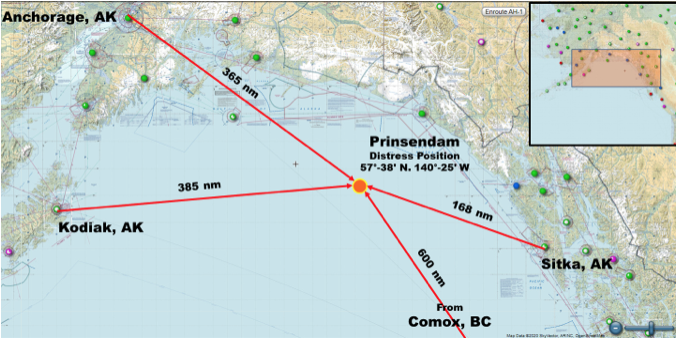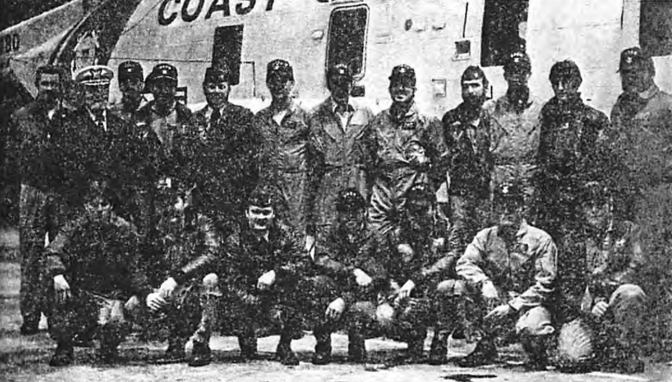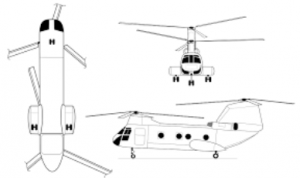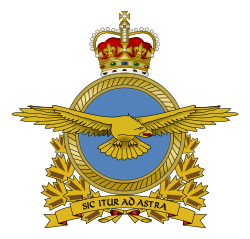 1 April 1924: The Royal Canadian Air Force (Aviation royale canadienne) was formed from the Canadian Air Force (CAF).
1 April 1924: The Royal Canadian Air Force (Aviation royale canadienne) was formed from the Canadian Air Force (CAF).
Tag Archives: Royal Canadian Air Force
29 December 1944
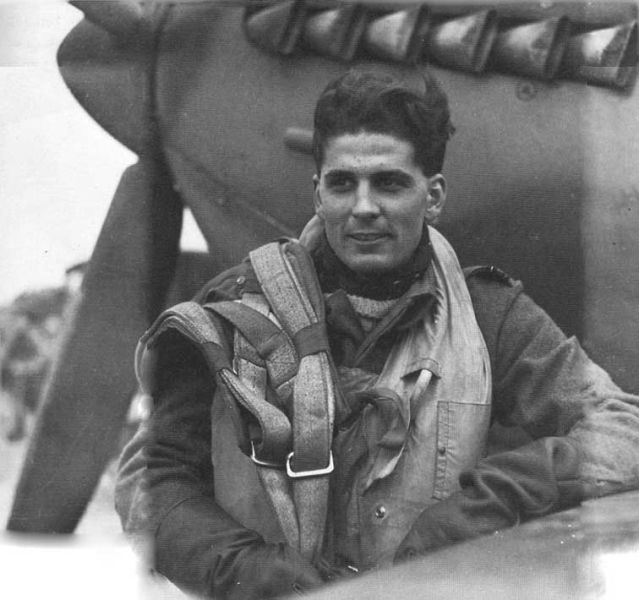
29 December 1944: Flying Officer Richard Joseph Audet, Royal Canadian Air Force, was a section leader of No. 411 Squadron, an RCAF squadron under the control of the Second Tactical Air Force, Royal Air Force. The squadron was based at an advanced airfield in The Netherlands.
In the early afternoon, Audet’s Yellow Section engaged a flight of twelve Luftwaffe fighters, four Messerchmitt Bf 109s and eight Focke-Wulf Fw 190s, near Rheine, in northwestern Germany.
Flying a Supermarine Spitfire LF Mk.IX .5, RR201, Flying Officer Audet led his section into the attack. He later reported:
I was leading Yellow section of 411 Squadron in the Rheine/Osnabruck area when Control reported Huns at Rheine and the squadron turned in that direction. An Me 262 was sighted and just at that time I spotted 12 e/a on our starboard side at 2 o’clock. These turned out to be a mixture of approximately 4 Me 109’s and 8 FW 190’s.
1) I attacked an Me 109 which was the last a/c in the formation of about twelve all flying line astern. At approximately 200 yds and 30° to starboard at 10,000 feet I opened fire and saw strikes all over the fuselage and wing roots. The 109 burst into flames on the starboard side of the fuselage only, and trailed intense black smoke. I then broke off my attack.
2) After the first attack I went around in a defensive circle at about 8500 feet until I spotted an FW 190 which I immediately attacked from 250 yards down to 100 yards and from 30° to line astern. I saw strikes over cockpit and to the rear of the fuselage. It burst into flames from the engine back, and as I passed very close over top of it I saw the pilot slumped over in his cockpit, which was also in flames.
3) My third attack followed immediately on the 2nd. I followed what I believed was an Me 109 in a slight dive. He then climbed sharply and his coupe top flew off at about 3 to 4,000 feet. I then gave a very short burst from about 300 yards and line astern and his aircraft whipped downwards in a dive. The pilot attempted or did bale out. I saw a black object on the edge of the cockpit but his ‘chute ripped to shreds. I then took cine shots of his a/c going to the ground and bits of parachute floating around. I saw this aircraft hit and smash into many flaming pieces on the ground. I do not remember any strikes on this aircraft. The Browning button only may have been pressed.
4) I spotted a FW 190 being pursued at about 5,000′ by a Spitfire which was in turn pursued by an FW 190. I called this Yellow section pilot to break and attacked the 190 up his rear. The fight went downwards in a steep dive. When I was about 250 yards and line astern of this 190 I opened fire. There were many strikes on the length of the fuselage and it immediately burst into flames. I saw this FW 190 go straight into the ground and burn.
5) Several minutes later while attempting to form my section up again I spotted an FW 190 from 4000 feet. He was at about 2000 feet. I dived down on him and he turned in to me from the right. Then he flipped around in a left hand turn and attempted a head-on attack. I slowed down to wait for the 190 to flypast in range. At about 200 yds and 20° I gave a very short burst, but couldn’t see any strikes. This a/c flicked violently, and continued to do so until he crashed into the ground. The remainder of my section saw this encounter and Yellow 4 (F/O McCracken) saw it crash in flames.
—Post Mission Report of Flying Officer R. J. Audet, 29 December 1944
This air battle had been Flying Officer Audet’s first engagement with enemy aircraft. It was over within a matter of minutes. For his actions of 29 December 1944, Richard Audet was awarded the Distinguished Flying Cross.
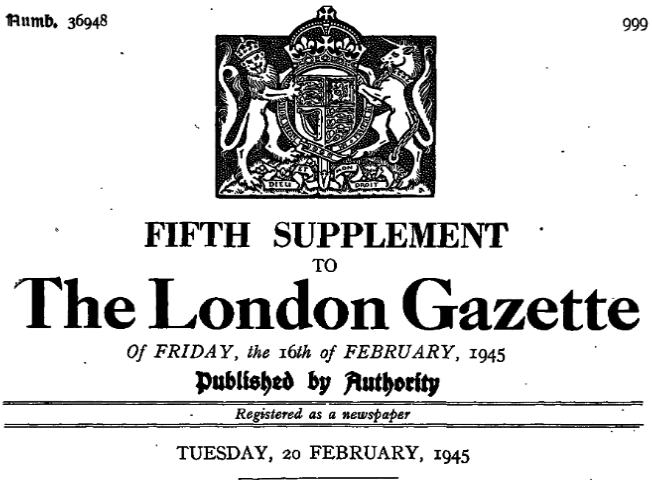 Air Ministry, 16th February, 1945.
Air Ministry, 16th February, 1945.
The KING has been graciously pleased to approve the following awards in recognition of gallantry and devotion to duty in the execution of air operations:—
Distinguished Flying Cross.
Flying Officer Richard Joseph Audet (Can/J.20136), R.C.A.F., 411 (R.C.A.F.) Sqn.
This officer has proved himself to be a highly skilled and courageous fighter. In December, 1944, the squadron was involved in an engagement against 12 enemy fighters in the Rheine/Osnabrück area. In a most spirited action, Flying Officer Audet achieved outstanding success by destroying 5 enemy aircraft. This feat is a splendid tribute to his brilliant shooting, great gallantry and tenacity.
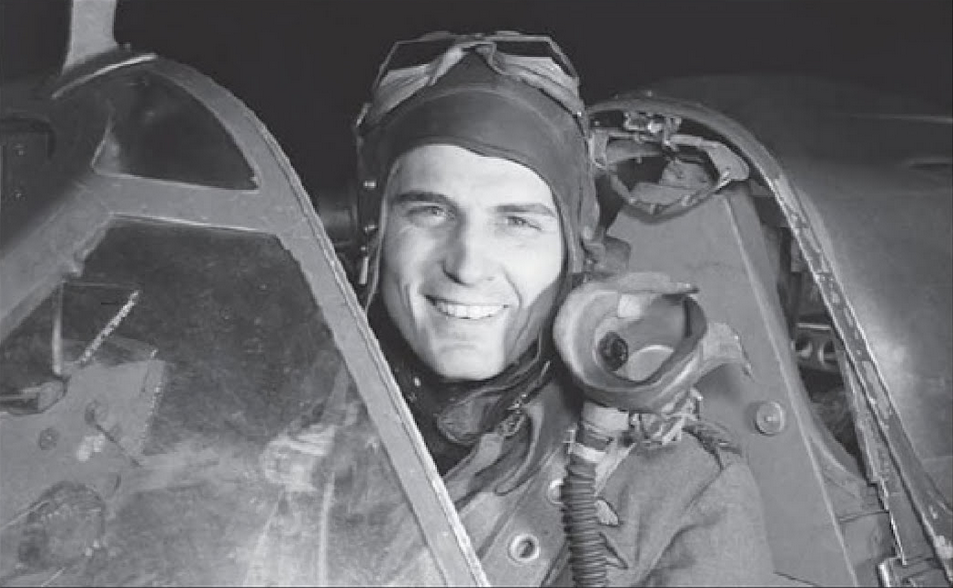
Richard Joseph Audet was born 13 March 1922 at Lethbridge, Alberta, Canada. He was the sixth child of Paul Audet, a rancher, and Ediwisca Marcoux Audet. “Dickie” Audet rode a horse to school at the age of ten years, traveling about 18 miles (29 kilometers) every morning.
Audet studied at Garbutt Business College in Lethbridge, and worked as a stenographer and bookkeeper at RCAF Air Station High River.
Dick Audet enlisted in the Royal Canadian Air Force at Calgary, Alberta, 28 August 1941. He was trained as a fighter pilot and was commissioned as a Pilot Officer, 24 October 1942. His pilot’s wings were presented to him by The Right Honourable William Lyon MacKenzie King, tenth Prime Minister of the Dominion of Canada.
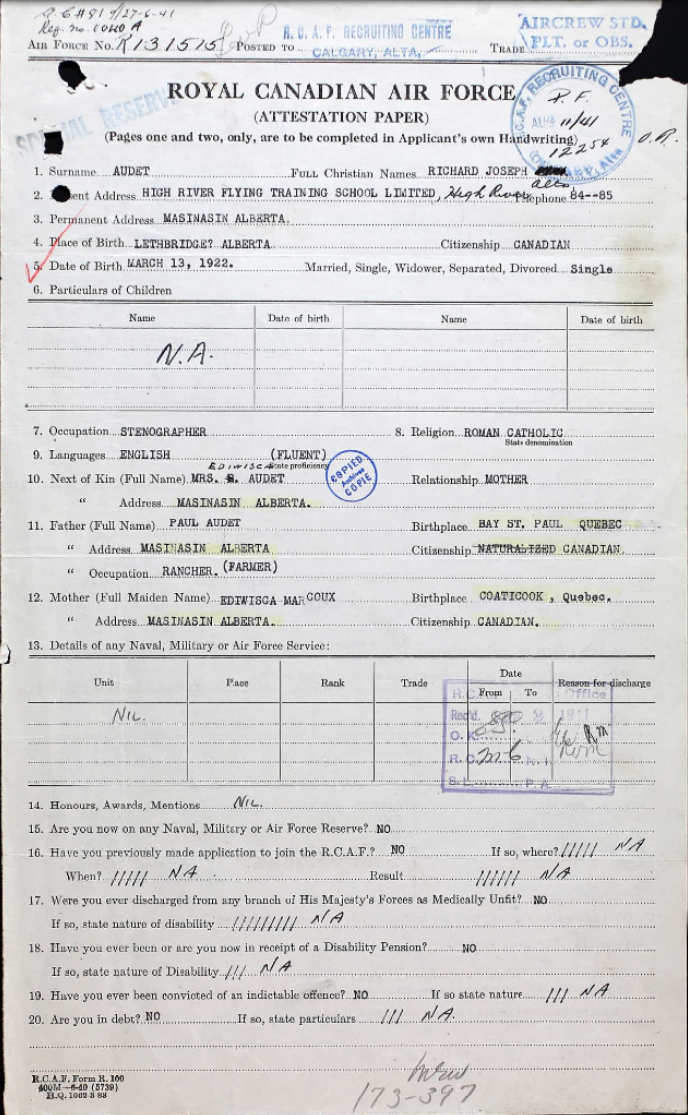
Pilot Officer Audet was sent to England, crossing the North Atlantic aboard ship and arriving 6 December 1942. He was assigned to the No. 6 Elementary Flying School at RAF Little Rissington, Gloucestershire, and then No. 17 Advanced Flying Unit at RAF Calvely, Nantwich, Cheshire. He was promoted to Flying Officer 23 April 1943, and transferred to No. 53 Operational Training Unit at RAF Heston, west of London, where he transitioned to the Supermarine Spitfire fighter.
Flying Officer Richard J. Audet married Miss Iris Christina Gibbons of Pinner, a village in the London Borough of Harrow, at Northhampton, Northamptonshire, England, 9 July 1944.
Audet joined No. 411 Squadron, Royal Canadian Air Force, 14 September 1944. He was promoted to the rank of Flight Lieutenant, 23 October 1944.
During January 1945, Flight Lieutenant Audet was credited with destroying another 6.5 enemy aircraft: 4.5 Focke-Wulf FW-190s (one shared) and two Messerschmitt Me 262 jet fighters (one on the ground), and a third Me 262, damaged.
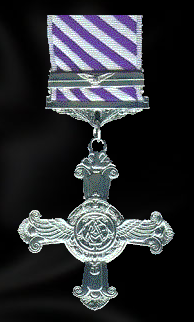
On 3 March 1945, Flight Lieutenant Audet was strafing railway trains near Coesfeld, Coesfelder Landkreis, Nordrhein-Westfalen, Germany, when his Spitfire LF Mk.IXE, MK950, was shot down. The Spitfire was seen to crash in flames and explode. Audet was listed as missing in action, and was presumed to have been killed. His remains were not recovered.
On 9 March 1945, Flight Lieutenant Richard Joseph Audet was posthumously awarded a Bar to his Distinguished Flying Cross (a second award).
There is no grave for Dick Audet. His name appears with those of 20,287 others on the Runnymede Memorial, Surrey, England, and among the nearly 400 on the Lethbridge Cenotaph at Lethbridge, Alberta. Audet Lake, north of Fort McMurray, Alberta, and Rue Richard Joseph Audet in Saugenay, Quebec, were named in his honor.

 The aircraft flown by Dick Audet on 29 December 1944, was a Supermarine Spitfire LF Mk.IX .5 (redesignated LF Mk.IXe in 1945), Royal Air Force serial number RR201. The identification letters on the fuselage were DB-G. It was built at built at the Castle Bromwich Aircraft Factory, at Warwickshire, West Midlands, in late summer or early fall 1944.
The aircraft flown by Dick Audet on 29 December 1944, was a Supermarine Spitfire LF Mk.IX .5 (redesignated LF Mk.IXe in 1945), Royal Air Force serial number RR201. The identification letters on the fuselage were DB-G. It was built at built at the Castle Bromwich Aircraft Factory, at Warwickshire, West Midlands, in late summer or early fall 1944.
The Supermarine Spitfire was a single-place, single-engine low-wing monoplane of all-metal construction with retractable landing gear. The fighter had been designed by Reginald Joseph Mitchell CBE. The prototype first flew 5 March 1936.
The Spitfire LF Mk.IXe was optimized for low-altitude operations. The Spitfire F Mk.Vb was 29 feet, 11 inches (9.119 meters) long with a wingspan of 36 feet, 10 inches (11.227 meters) and overall height of 11 feet, 5 inches (3.480 meters). The exact dimensions of the LF Mk.IXe are not known but are presumably similar. Some Mk.IXe fighters had “clipped” wings, while others did not.
The LF Mk.IXe had an empty weight of 5,749 pounds (2,608 kilograms) and gross weight of 7,450 pounds (3,379 kilograms).
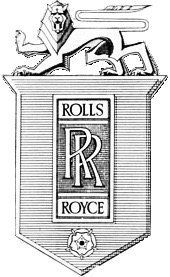 The Spitfire LF Mk.IXe was powered a liquid-cooled, supercharged, 1,648.959-cubic-inch-displacement (27.022 liters) Rolls-Royce Merlin 66 single overhead camshaft (SOHC) 60° V-12 engine with a compression ratio of 6.00:1. It was equipped with a two-speed, two-stage supercharger. The Merlin 66 was rated at 1,315 horsepower at 3,000 r.p.m. and 12 pounds per square inch boost (0.83 Bar), for Take Off; 1,705 horsepower at 3,000 r.p.m. at 5,750 feet (1,753 meters) and 1,580 horsepower at 3,000 r.p.m. at 16,000 feet (4,877 meters), with 18 pounds boost (1.24 Bar). These power ratings were obtained with 130-octane aviation gasoline. When 150-octane gasoline became available, the Merlin 66 was cleared to use 25 pounds of boost (1.72 Bar). The Merlin 66 had a propeller gear reduction ratio of 0.477:1 and drove a four-bladed Rotol Hydulignum (compressed laminated wood) propeller with a diameter of 10 feet, 9 inches (3.277 meters). The engine weighed 1,645 pounds (746 kilograms).
The Spitfire LF Mk.IXe was powered a liquid-cooled, supercharged, 1,648.959-cubic-inch-displacement (27.022 liters) Rolls-Royce Merlin 66 single overhead camshaft (SOHC) 60° V-12 engine with a compression ratio of 6.00:1. It was equipped with a two-speed, two-stage supercharger. The Merlin 66 was rated at 1,315 horsepower at 3,000 r.p.m. and 12 pounds per square inch boost (0.83 Bar), for Take Off; 1,705 horsepower at 3,000 r.p.m. at 5,750 feet (1,753 meters) and 1,580 horsepower at 3,000 r.p.m. at 16,000 feet (4,877 meters), with 18 pounds boost (1.24 Bar). These power ratings were obtained with 130-octane aviation gasoline. When 150-octane gasoline became available, the Merlin 66 was cleared to use 25 pounds of boost (1.72 Bar). The Merlin 66 had a propeller gear reduction ratio of 0.477:1 and drove a four-bladed Rotol Hydulignum (compressed laminated wood) propeller with a diameter of 10 feet, 9 inches (3.277 meters). The engine weighed 1,645 pounds (746 kilograms).
The Spitfire LF Mk.IXe had cruise speed of 220 miles per hour (354 kilometers per hour) at 20,000 feet (6,096 meters); a maximum speed of 384 miles per hour (618 kilometers per hour) at 10,500 feet (3,200 meters), and 404 miles per hour (650 kilometers per hour) at 21,000 feet (6,401 meters). Diving speed was restricted to 450 miles per hour (724 kilometers per hour) below 20,000 feet (6,096 meters). The airplane’s service ceiling was 42,500 feet (12,954 meters).
The Spitfire LF Mk.IXe was armed with two 20-milimeter Hispano Mk.II autocannon, with 135 rounds of ammunition per gun, and two Browning AN-M2 .50-caliber machine guns, with 260 rounds per gun. The .50-caliber machine guns were mounted in the wings, just inboard of the 20 mm cannon.
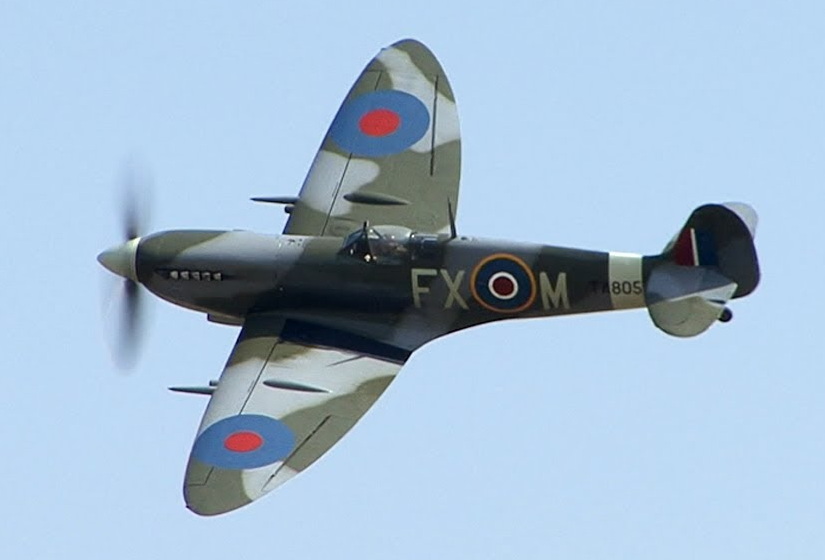
© 2018, Bryan R. Swopes
11 December 1941
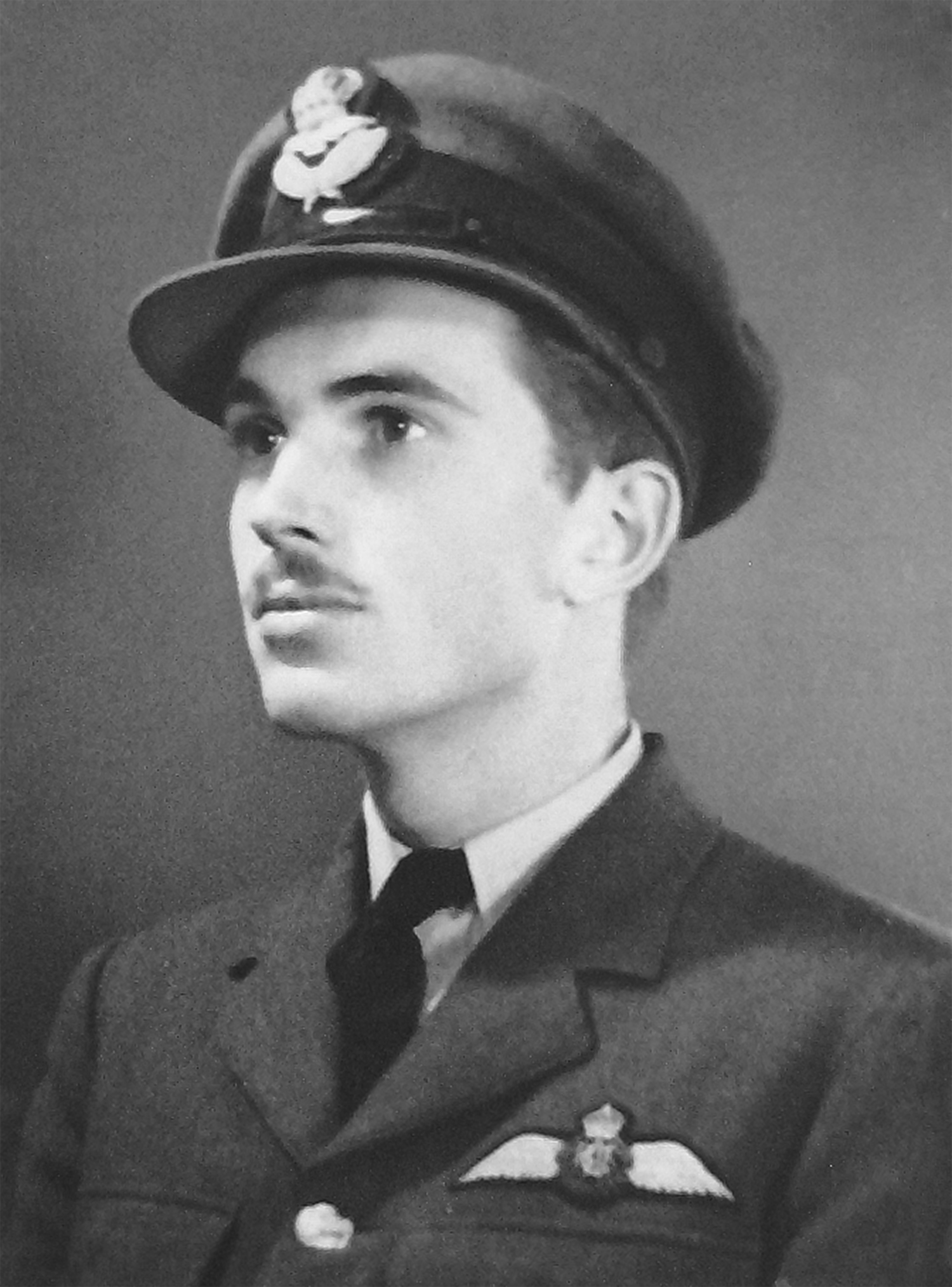
11 December 1941: Pilot Officer John Gillespie Magee, Jr., Royal Canadian Air Force, an American serving in England before the United States entered World War II, was killed when his Supermarine Spitfire collided with another airplane in clouds over the village of Roxholm, Lincolnshire, England. He was only 19 years old.
Magee was born in China, the son of Anglican missionaries. His father was an American, giving him American citizenship, and his mother was from England. He was educated in the missionary schools until 1931 when his mother took him to England to continue his education at the Rugby School in Wawickshire.
In 1939, Magee traveled to the United States to visit his father’s family in Pittsburgh, but because of the outbreak of World War II, he was unable to return to England. While in America, he continued his schooling at the Old Avon Farms School in Connecticut and won a scholarship to Yale University.
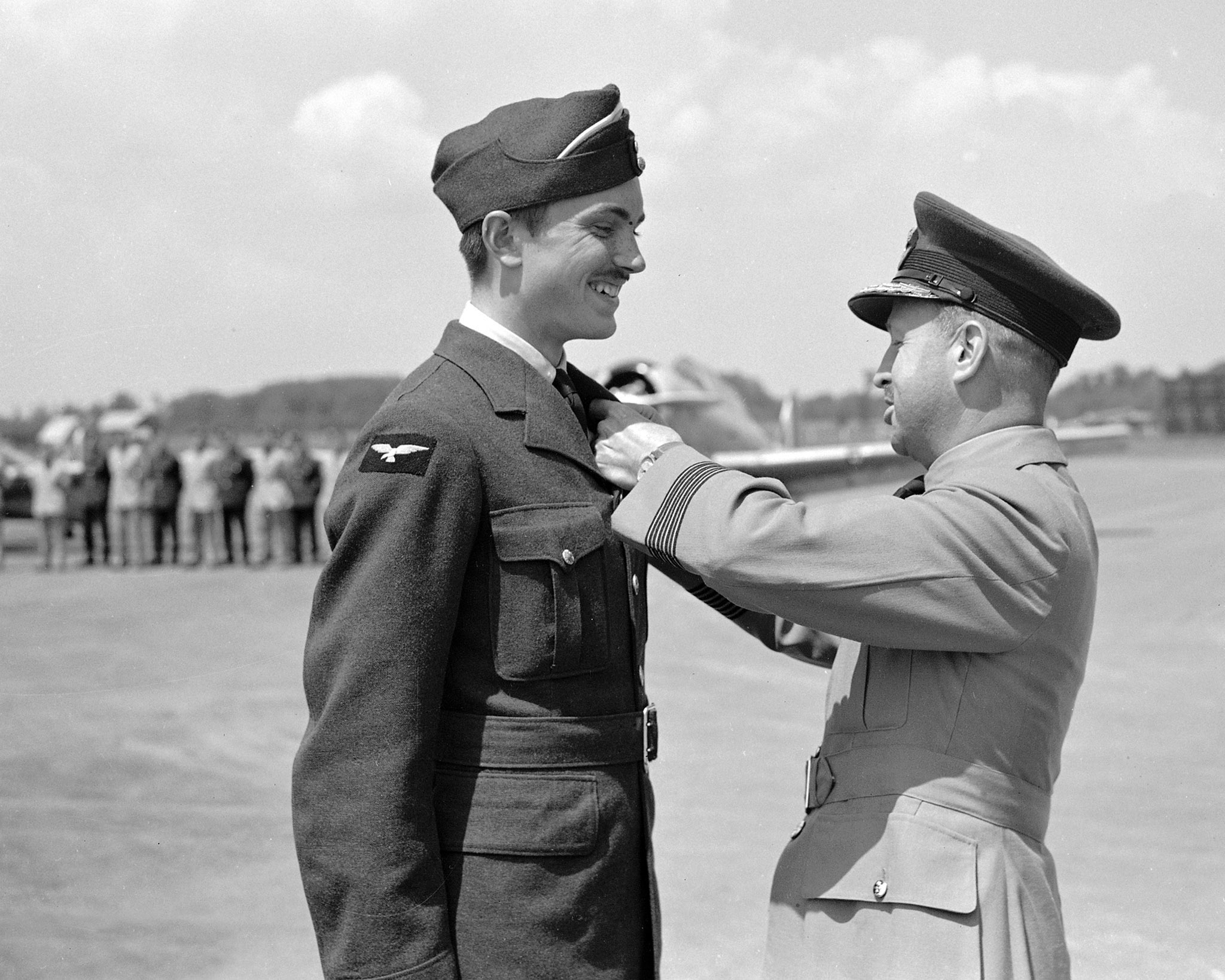
Instead of studying at Yale, in 1941, John Magee enlisted in the Royal Canadian Air Force. After completing flight training, he was sent to England. Once there he went through operational training in the Supermarine Spitfire and was assigned to No. 412 (Fighter) Squadron at RAF Digby, Scopwick Heath, and then at RAF Wellingore, Navenby, both in Lincolnshire.
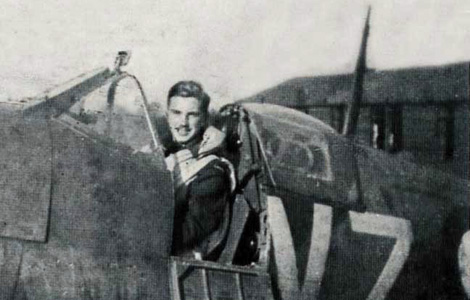
At approximately 11:30 a.m., 11 December 1941, Pilot Officer Magee was flying his Supermarine Spitfire Mk.Vb, AD291, squadron markings VZ-H. He and three other pilots from No. 412 Squadron descended through a hole in the clouds. At 1,400 feet (427 meters), Magee’s Spitfire collided with an Airspeed A.S. 10 Oxford twin-engine trainer, T1052.
A witness said that he saw the Spitfire pilot struggle to open the airplane’s canopy, then stand up in the cockpit and jump from the doomed fighter. The pilot was too close to the ground for his parachute to open.
Both airplanes crashed. Pilot Officer John Gillespie Magee, Jr. was killed, as was the pilot of the other airplane, Leading Aircraftman Ernest Aubrey Griffin.
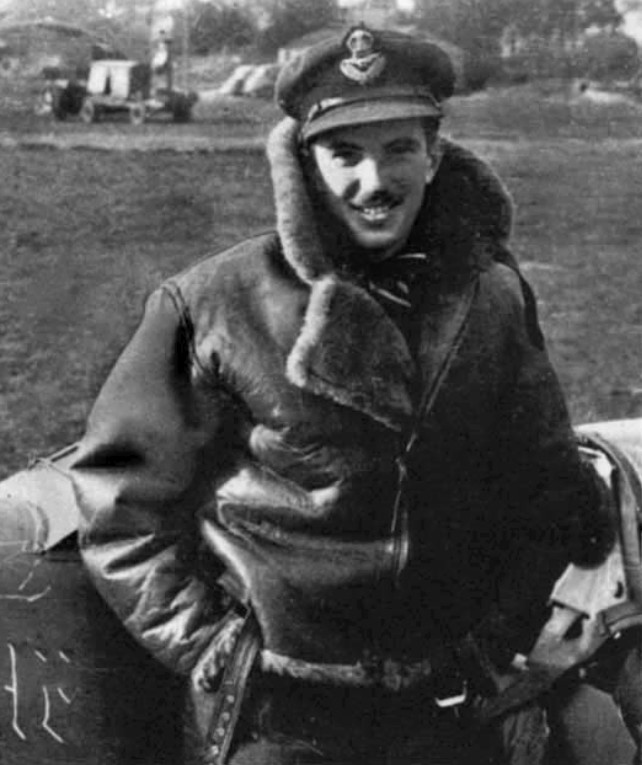
Pilot Officer Magee is best known for his poem, High Flight:
Oh! I have slipped the surly bonds of Earth
And danced the skies on laughter-silvered wings;
Sunward I’ve climbed, and joined the tumbling mirth
of sun-split clouds,—and done a hundred things
You have not dreamed of—wheeled and soared and swung
High in the sunlit silence. Hov’ring there,
I’ve chased the shouting wind along, and flung
My eager craft through footless halls of air. . . .
Up, up the long, delirious, burning blue
I’ve topped the wind-swept heights with easy grace
Where never lark nor ever eagle flew—
And, while with silent lifting mind I’ve trod
The high untrespassed sanctity of space,
Put out my hand, and touched the face of God
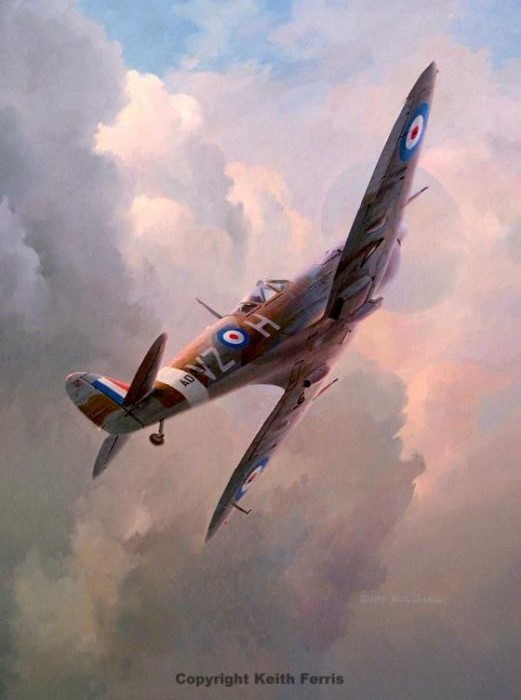
A less well-know poem by Magee is Per Ardua, written after his first combat mission, 8 November 1941.
(To those who gave their lives to England during the Battle of Britain and
left such a shining example for us to follow, these lines are dedicated.)
They must have climbed the white mists of the morning;
They that have soared, before the world’s awake,
To herald up their foemen to them, scorning
The thin dawn’s rest their weary folk might take;
Some that left other mouths to tell the story
Of high blue battle,—quite young limbs that bled;
How they had thundered up the clouds to glory
Or fallen to an English field stained red;
Because my faltering feet would fail I find them
Laughing beside me, steadying the hand
That seeks their deadly courage—yet behind them
The cold light dies in that once brilliant land …
Do these, who help the quickened pulse run slowly,
Whose stern remembered image cools the brow—
To the far dawn of Victory know only
Night’s darkness, and Valhalla’s silence now?

John Magee’s fighter was a Supermarine Spitfire F. Mk Vb, built at the Castle Bromwich Aircraft Factory, at Warwickshire, West Midlands, and delivered to the 45th Maintenance Unit at RAF Kinloss, Scotland, on 27 September 1941. The new airplane was assigned to No. 412 Squadron on 14 October.
The Supermarine Spitfire was a single-place, single-engine low-wing monoplane of all-metal construction with retractable landing gear. The fighter had been designed by Reginald Joseph Mitchell CBE. The prototype first flew 5 March 1936.
The Spitfire F. Mk Vb was 29 feet, 11 inches (9.119 meters) long with a wingspan of 36 feet, 10 inches (11.227 meters) and overall height of 11 feet, 5 inches (3.480 meters). It had an empty weight of 4,963 pounds (2,129 kilograms) and gross weight of 6,525 pounds (2,960 kilograms).
The Spitfire Vb was powered a liquid-cooled, supercharged, 1,648.959-cubic-inch-displacement (27.022 liters) Rolls-Royce Merlin 45 single overhead camshaft (SOHC) 60° V-12 engine with a single-speed, single-stage supercharger. It was rated at 1,185 horsepower at 3,000 r.p.m., at 11,500 feet (3,505 meters). The Merlin 45 drove a three-bladed Rotol constant-speed propeller with a diameter of 10 feet, 9 inches (3.277 meters).
The Spitfire Vb had a maximum speed of 371 miles per hour (597 kilometers per hour) at 20,100 feet (6,126 meters). It could reach 20,000 feet (6,096 meters) in 6 minutes, 24 seconds, and 30,000 feet (9,144 meters) in 12 minutes, 12 seconds. The Vb’s service ceiling 37,500 feet (11,430 meters), and its range was 470 miles (756 kilometers).
The Spitfire F. Mk Vb was armed with two 20-milimeter Hispano Mk.II autocannon, with 60 rounds of ammunition per gun, and four Browning .303-caliber Mark II machine guns, with 350 rounds per gun.
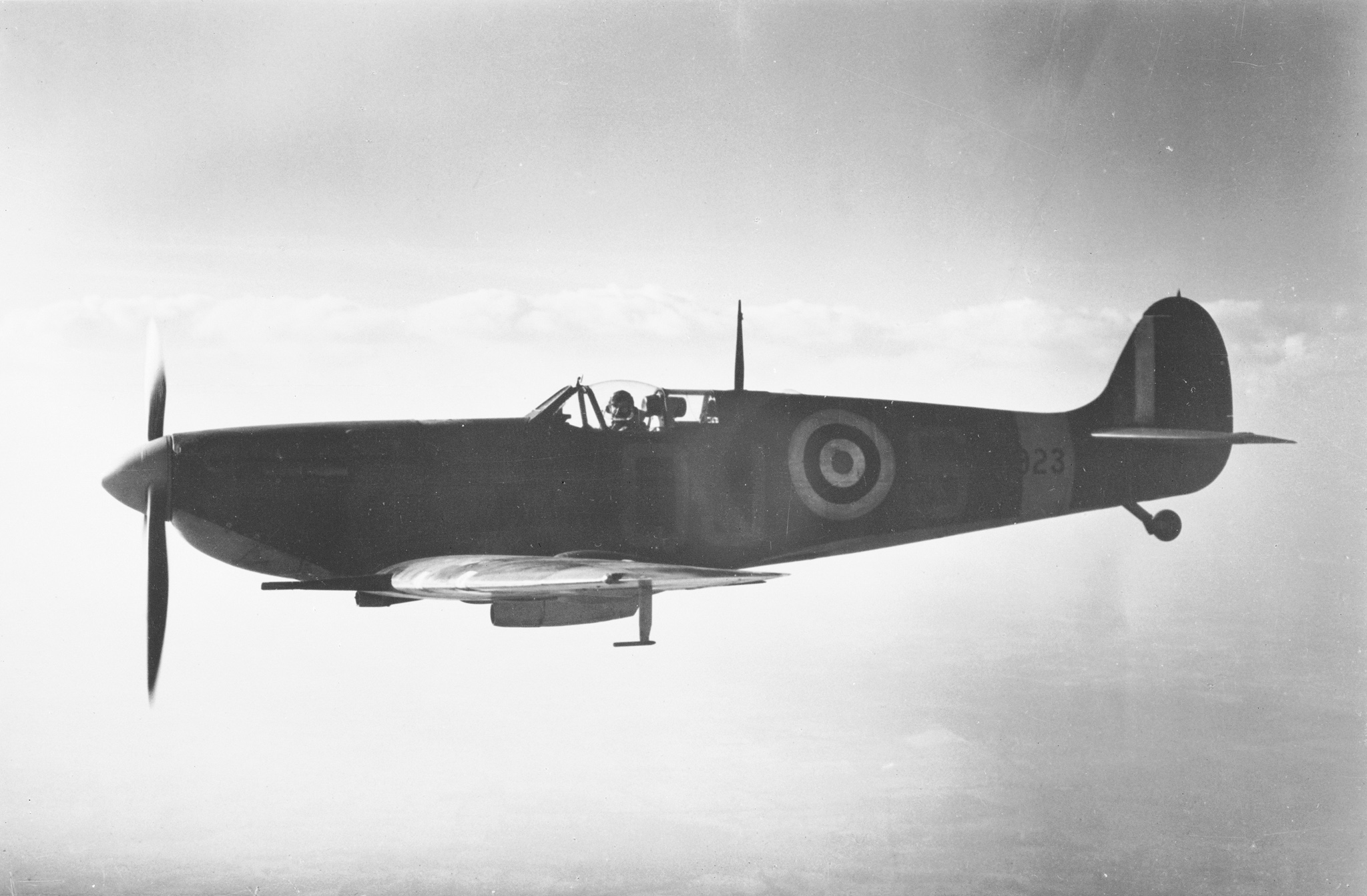
© 2016, Bryan R. Swopes
4 October 1980: This Day in U.S. Coast Guard Aviation History
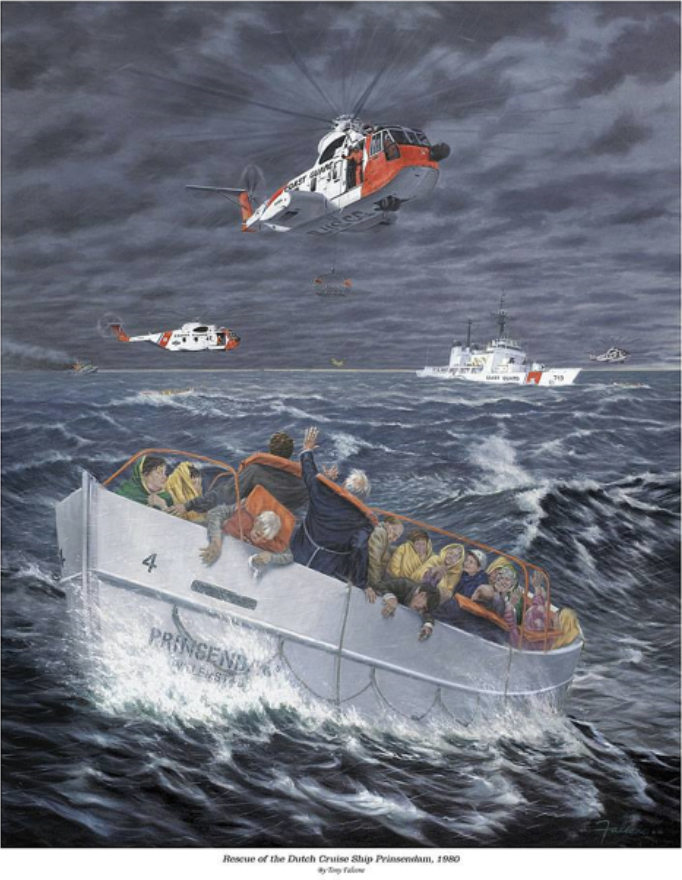 MIRACLE RESCUE: Cruise Liner PRINSENDAM—04 October 1980
MIRACLE RESCUE: Cruise Liner PRINSENDAM—04 October 1980
by Captain Sean M. Cross, United States Coast Guard (Retired)
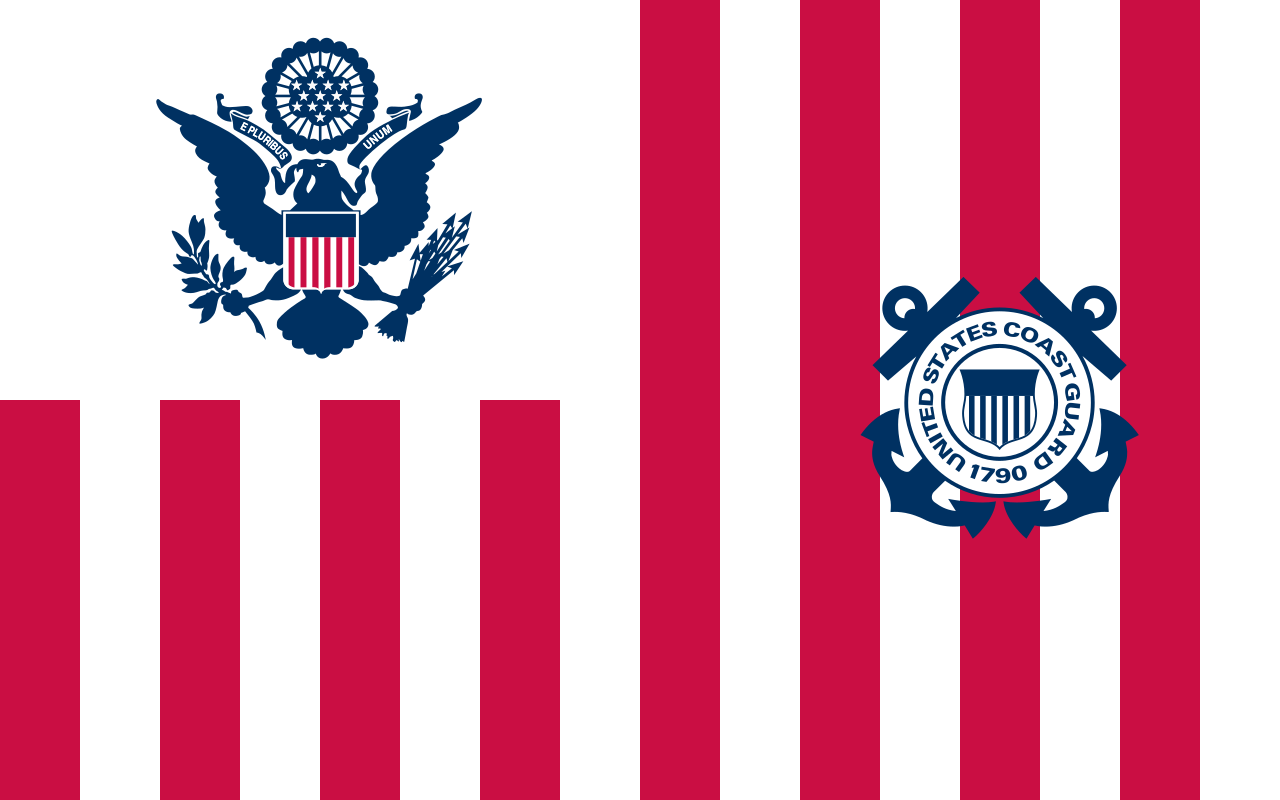 On this day in 1980, the United States Coast Guard led one of the nation’s largest search and rescue cases when the 519 passengers and crew of the Dutch cruise liner PRINSENDAM were forced to abandon ship more than 130 miles (209 kilometers) off the coast of Alaska after an engine room fire spread throughout the vessel. Over the course of 24 hours, rescue aircraft deployed from Coast Guard Air Stations Sitka and Kodiak, AK. would work side-by-side with the U.S. Air Force, Royal Canadian Armed Forces as well as U.S. Coast Guard Cutters BOUTWELL, WOODRUSH, MELLON and an AMVER-tasked (Automated Mutual-Assistance Vessel Rescue System) tanker WILLIAMSBURG to rescue all hands from 12 to 15 foot (18–24 meters) seas and 25 to 30 knot (13–15 meters per second) winds generated by a nearby Arctic typhoon.
On this day in 1980, the United States Coast Guard led one of the nation’s largest search and rescue cases when the 519 passengers and crew of the Dutch cruise liner PRINSENDAM were forced to abandon ship more than 130 miles (209 kilometers) off the coast of Alaska after an engine room fire spread throughout the vessel. Over the course of 24 hours, rescue aircraft deployed from Coast Guard Air Stations Sitka and Kodiak, AK. would work side-by-side with the U.S. Air Force, Royal Canadian Armed Forces as well as U.S. Coast Guard Cutters BOUTWELL, WOODRUSH, MELLON and an AMVER-tasked (Automated Mutual-Assistance Vessel Rescue System) tanker WILLIAMSBURG to rescue all hands from 12 to 15 foot (18–24 meters) seas and 25 to 30 knot (13–15 meters per second) winds generated by a nearby Arctic typhoon.
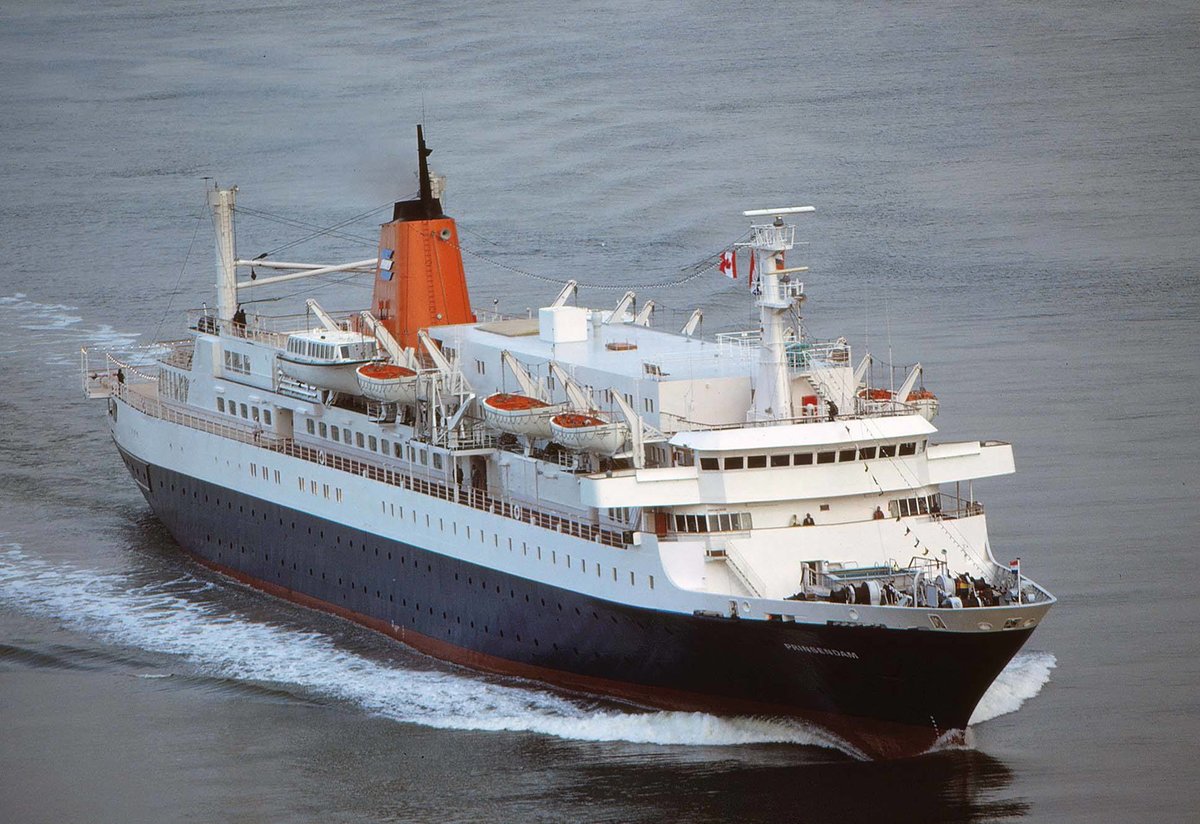
The PRINSENDAM was a 427-foot (130 meters) long cruise liner built in 1973. The liner was transiting through the Gulf of Alaska, approximately 120 miles (193 kilometers) south of Yakutat, Alaska, at midnight October 4, 1980, when fire broke out in the engine room. With conditions too dangerous for the deployment of small boats from the ships, most survivors were hoisted and ferried to surface ships while some were ferried to shore during helicopter refuel transits. The helicopters would then refuel and head back out to the scene for their next load of passengers. Still others were forced to climb aboard the tanker and cutters with the help of two Air Force pararescuemen while hypothermic.
The rescue of the PRINSENDAM was particularly significant because of the distance traveled by the rescuers, the coordination of independent organizations and the fact that all 519 passengers and crew were rescued under challenging environmental conditions without loss of life or serious injury.
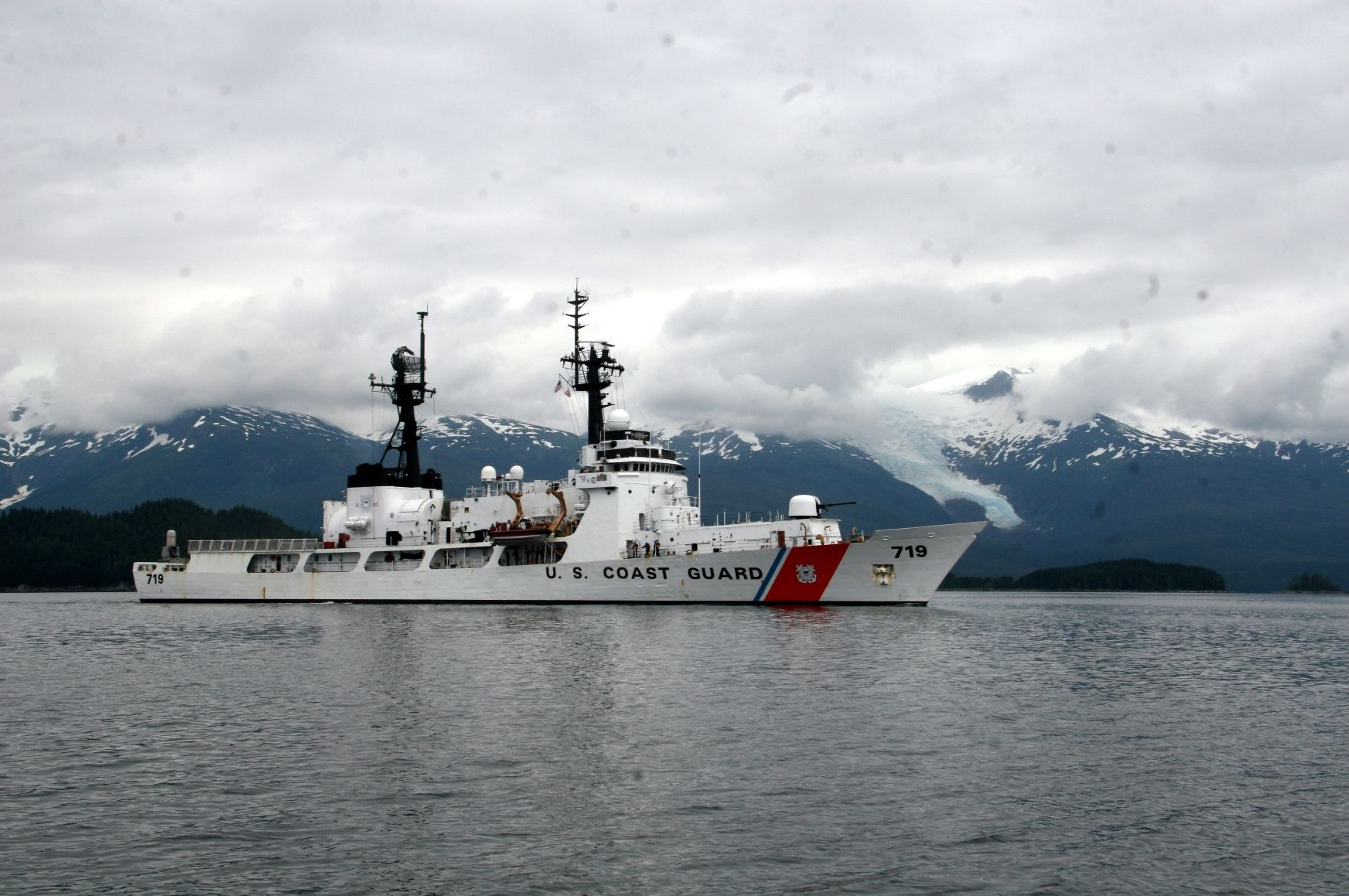
The following aircraft participated:
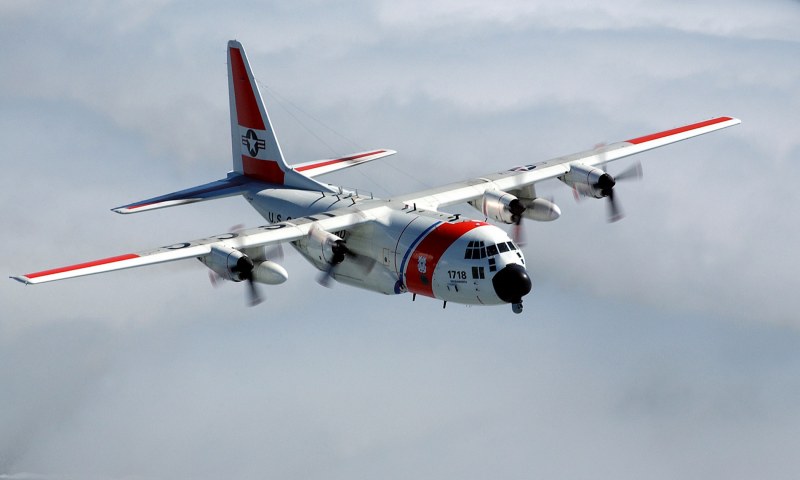
• Two Coast Guard HH-3F helicopters and two HC-130H aircraft from Air Station Kodiak. Distance 385 nautical miles (443 statute miles/713 kilometers) from PRINSENDAM.
• Alaskan Air Command Rescue Coordination Center (RCC), Elmendorf Air Force Base, Anchorage and 71st Aerospace Rescue and Recovery Squadron: one HH-3E helicopter and one HC-130H Hercules. Distance: over 370 nautical miles (426 statute miles/595 kilometers).
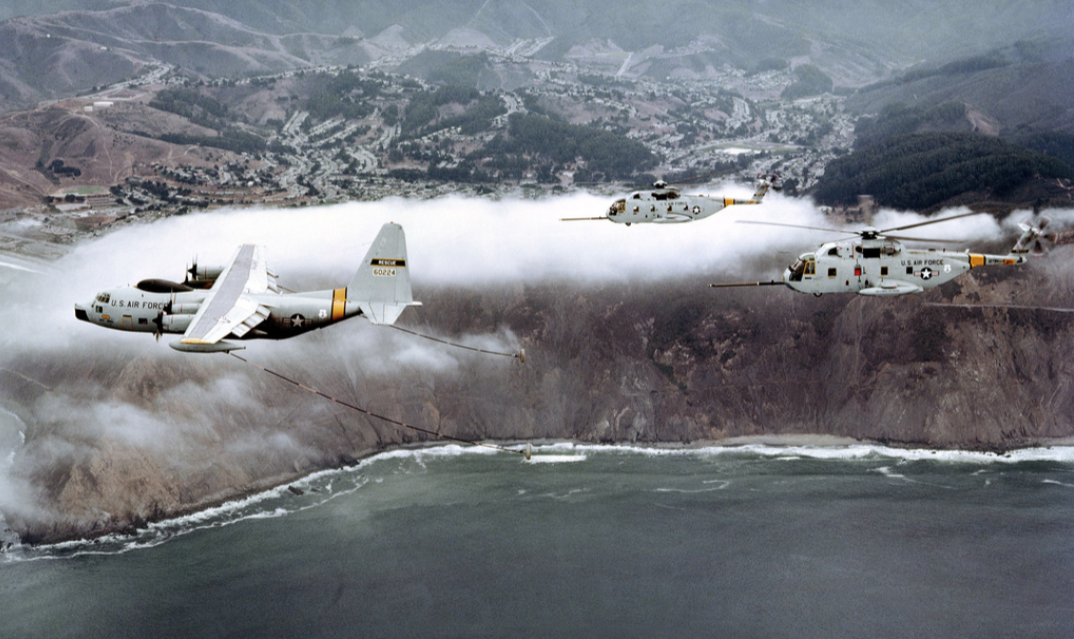
• Two Coast Guard HH-3F helicopters from Air Station Sitka. Distance: 170 nautical miles (196 statute miles/315 kilometers).
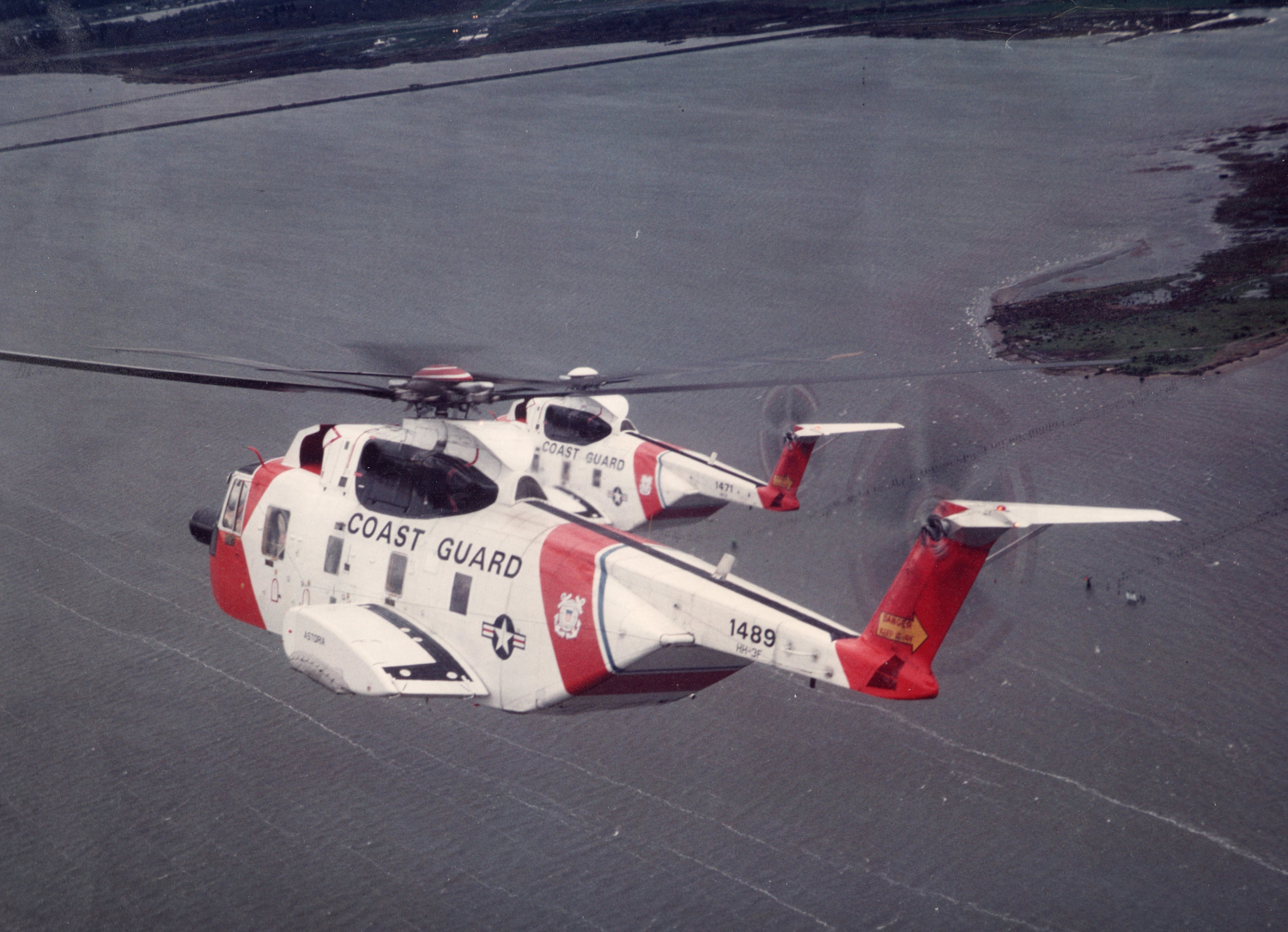
• Canadian Forces from 442 Transport and Rescue Squadron, 19 Wing Comox, British Columbia: Two CH-113 Labradors (CH-46) helicopters, two CC-115 Buffalo aircraft and one CP-107 Argus (from 407 Maritime Patrol Squadron). Distance: over 600 nautical miles (690 statute miles/1,111 kilometers).
U.S. Coast Guard rescue coordination centers began receiving Morse code SOS distress signals from the PRINSENDAM reporting a fire onboard a few minutes prior to 1 a.m. Saturday morning October 4, 1980. A few hours later, at 05:08 a.m., with fire visible on deck, 329 passengers were directed to take to lifeboats about 120 miles offshore in the frigid Gulf of Alaska.
The on-scene operation required unrehearsed teamwork by the U.S. Coast Guard, the U.S. Air Force and two Canadian units flying in close proximity. Overhead, the five long-range reconnaissance aircraft including the U.S. HC-130Hs and the Canadian CP-107 Argus aircraft staged and coordinated helicopter assets while acting as long range communication platforms. Behind the scenes, CC-115 Buffalos from the 442 Squadron operated a shuttle service between shore bases and staging areas, carrying medics, firefighters, supplies, fresh helicopter crews and rescued passengers.
The first 12 to 24 hours of a distress incident offers the best chance of successful rescue and recovery of survivors. After 48 hours chances of a successful rescue and recovery decrease rapidly. The remote and isolated location of the burning PRINSENDAM (and its lifeboats and life rafts) was barely within the timely response capability of the personnel and equipment available. The risks included—but were not limited to—climatic, season, weather, distance from shore and logistics of getting rescue teams and resources to the burning PRINSENDAM’s location. The survivability hazards to both survivors and rescuers included—but were not limited to—remoteness and isolation of the PRINSENDAM’s location from help, water temperature, worsening weather and sea conditions combined with duration the survivors would be vulnerably exposed to the furry of sea and weather. The remnants of Typhoon Thelma heading directly towards the incident area would result in the operational environment becoming more perilous during the on-going rescue operations.
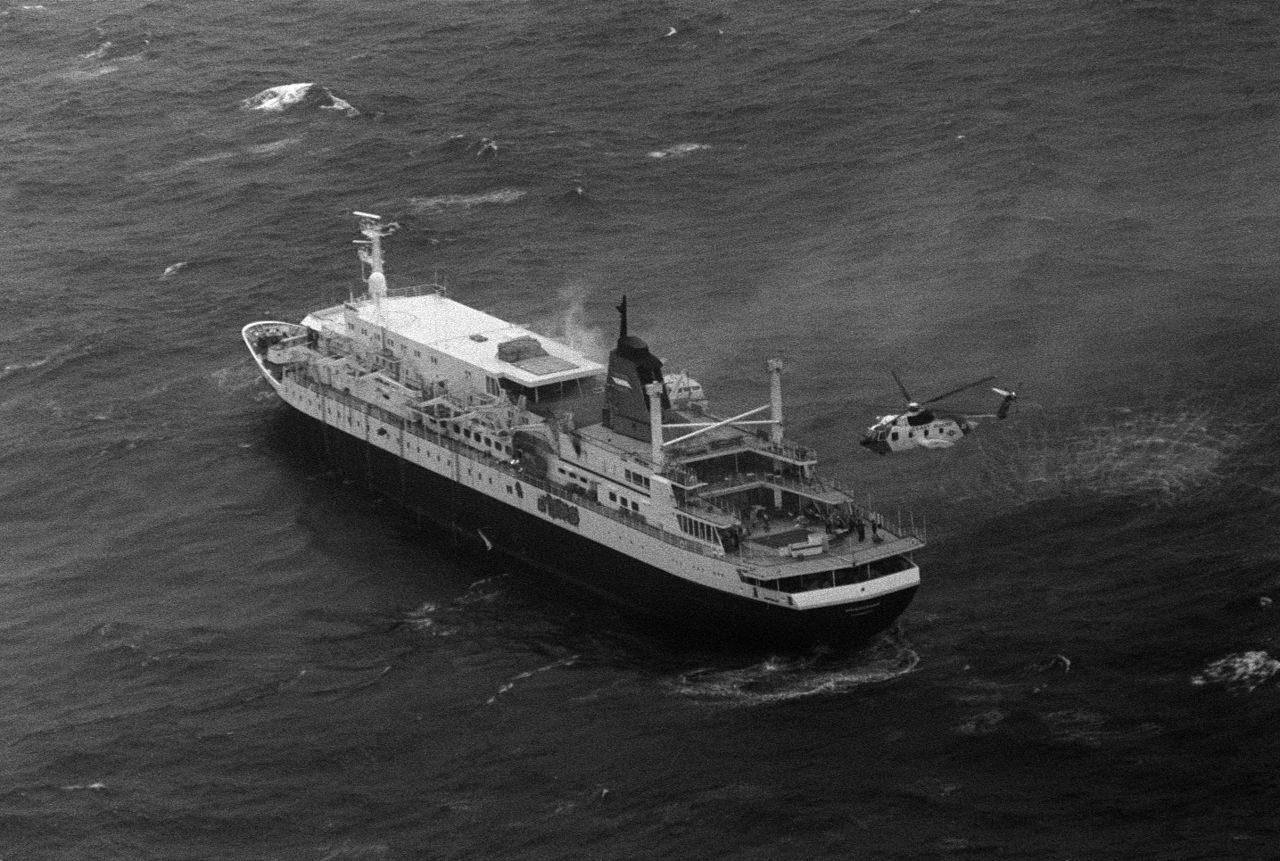
Commander Bruce Melnick, USCG (Retired), who was also designated Coast Guard Astronaut Number 1 in 1992, participated in the rescue as an HH-3F pilot and made the following comments in a 26 October 2016 interview:
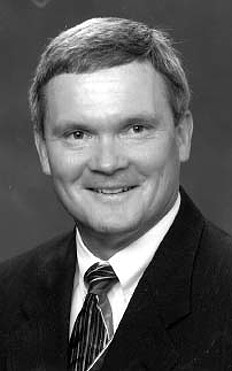
“I was on the Prinsendam mission, where there was a Dutch ship from Holland, America cruise lines called the Prinsendam, where I was the SDO that night and we got a call, and the radioman thought the name of the boat was the “Prince and Don” and I said, “Wow. That’s …” and he said, “It’s on fire and it’s out here somewhere.” So, I ran over to the radio room and then I was aware of the cruise ship Prinsendam, how it used to come into the port of Sitka, and so I said … I can’t remember the name of the radioman’s name. I’m sorry. I said but, “That’s the Prinsendam. That’s the big cruise ship and they’re on fire.” So, we talked to RCC and Juno and we launched out, flew out there. They were probably 180 miles away and when we got out there they were listing seriously to starboard and they thought they had the fire out, and then all of a sudden the fire erupted again and the captain of the ship ordered them to abandon ship. When they started to abandon ship, they had all kinds of problems and it was dark at night, and it wasn’t real bad weather yet. There was like a 10-foot swell, but it wasn’t real bad yet. So, we used the night sun ¹ on the H-3 to illuminate the people abandoning ship and we were there until just about everybody got off the ship, and then we were low fuel. By this time, the rest of the resources were being called in.
“The Canadian Forces, the Kodiak Coast Guard, the Elmendorf Air Force Base. I mean we had alerted everybody, and we flew into Yakutat for fuel. We got into Yakutat, we refueled and came back out and by that time, there was a C-130 on scene, some other forces were on scene and the winds had started to pick up real bad. About the time we got on scene, the rest of the helicopters had to go back in for refuel. Now the seas are you know, 15 feet, wind blowing and we looked down and we called back to the on scene commander and said, “We think we need to start hoisting these people,” because the tanker Williamsburg, great big, super tanker was out there and they were trying to get these people over to the side of the ship, the big tanker and climb up the Jacob’s ladders to get up onto the deck of the ship and the average age of these people was 70 years old. So we said, “We think we need to hoist these people,” and I’m not going to mention any names, but he was a senior officer from our air station said, “Whatever you do, don’t hoist those people.” Joel Thuma was the aircraft commander with me, and he was in the left seat at this time, because we had swapped seats, and he says, “Oh …you’re breaking up. I think we’re going to go ahead. I got you, we’re going to start hoisting.” So, we ended up starting the hoisting routine and everybody at the PJ started jumping in. Make a long story short, by the time my day was ended, I’d picked up 115 of the survivors, made multiple trips back and forth to the Williamsburg. At one point they had 24 survivors on the helicopter at one time, and then we took a load back to the Yakutat and anyway, we ended up picking up … we had 519 saves that day. I picked up 115 of them. Great mission and I can talk about that at a great length.”
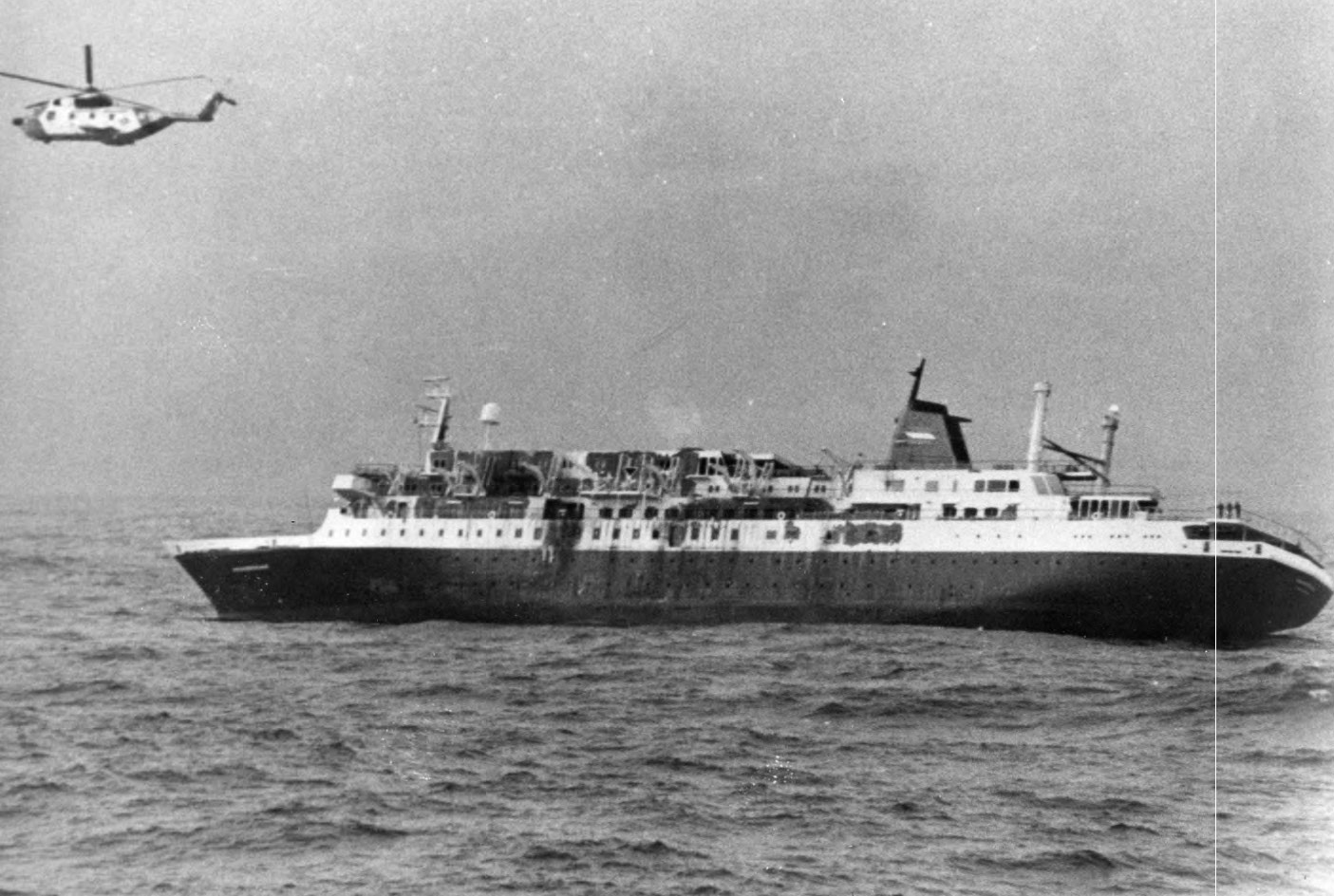
Aircrew rescue efforts continued around the clock for 24 hours. Despite the hardships and hazards of abandoning ship in the Gulf of Alaska about 120 miles offshore, all crew and passengers of the M.S. PRINSENDAM—329 passengers, 164 Indonesian crew members and 26 Dutch officers—were successfully rescued. With the exception of the U.S. Air Force HH-3E, which included an in-flight refueling probe, fuel endurance was a major factor, the other helicopters hoisted up as many people as they could from the lifeboats and dropped them on U.S. Coast Guard and AMVER surface vessels until they reached their fuel limits and returned to Yakutat, the closest point of land 130 miles away. This event led to the U.S. Coast Guard developing Helicopter In-Flight Refueling (HIFR) from surface vessels and implementing a Rescue Swimmer program. Interestingly, the next morning (05 October), BOUTWELL spotted a flare from a lifeboat containing the final 20 passengers and two Air Force technicians, completing the rescue of all 519 crewmembers and passengers. In 2007, after reaching the remarkable milestone of more than one million lives saved since 1790, the U.S. Coast Guard published a synopsis of the Top 10 rescues in the history of the Service – the PRINSENDAM rescue came in at number 2 behind the 2005 Hurricane KATRINA response. The combination of hardship, hazard, no loss of life, no significant injury has resulted in this incident being considered the greatest air-sea rescue operation in maritime history.
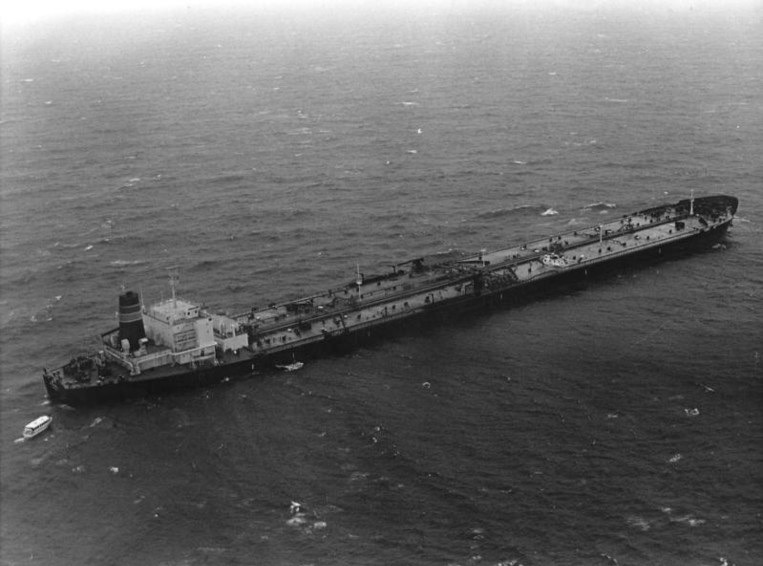
Helicopter Aircrews:
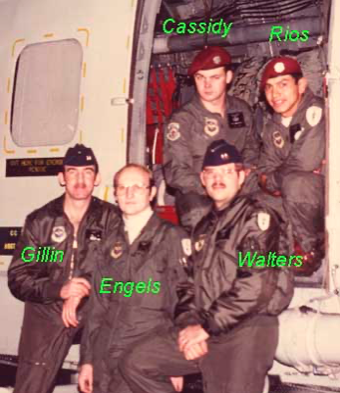 HH-3E (AF Rescue 802) crew was Captain John J. Walters-Aircraft Commander; Captain William T. Gillen-Copilot; Staff Sergeant Michael J. Engels-Flight Engineer; Staff Sergeant John F. Cassidy-Pararescue Team Leader; and, Sergeant Jose M. Rios-Pararescue Specialist.
HH-3E (AF Rescue 802) crew was Captain John J. Walters-Aircraft Commander; Captain William T. Gillen-Copilot; Staff Sergeant Michael J. Engels-Flight Engineer; Staff Sergeant John F. Cassidy-Pararescue Team Leader; and, Sergeant Jose M. Rios-Pararescue Specialist.
The Lifesavers: Crewmen of Air Station Sitka were the first on scene when PRINSENDAM sent out a distress call. Air Station Sitka flight crews: (back row, left to right) LCDR Ron Simond, CDR Chuck Peterson (commanding officer), LTJG Tom Vasilou, CDR Tom Morgan (executive officer), LCDR Ray Hiner, LCDR Joel Thuma, AT3 Richard McManigal, AE2 Andrew Falenski, LCDR Robert Knapp, AD3 Carl Saylor, ASM3 Richard Driscoll, and AT 2 Dave Cook. Front row: AE3 Ron Dupont, LT Dave Barnes, LT Bruce Melnick, AD3 Mike Oliverson, AM3 Sam Overman, AT1 Larry Weygandt, AD2 Tim Burkholder. Photo by AD1 Barfield.
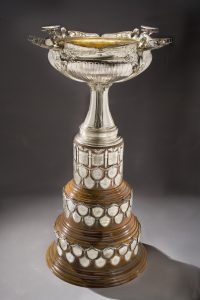
Captain John J. Walters, U.S. Air Force, of the 71st ARRS, was awarded the Mackay Trophy “For extraordinary achievement while participating in aerial flight as HH-3 Helicopter Commander in the rescue of 61, in adverse conditions, from the burning cruise ship Prinsendam.”
Captain Walters and Pararescue Specialists SSGT John Cassidy and SGT Jose Rios were awarded the Distinguished Flying Cross. Also receiving the Distinguished Flying Cross were CDR Thomas Morgan, USCG; LCDR Raymond Hiner, USCG; LCDR Robert Knapp, USCG; LCDR Joel Thuma, USCG; LT Bruce Melnick, USCG; AT2 David Cook, USCG; AD3 Mike Olverson, USCG; AM3 Samuel Overman, USCG; and AD3 Carl Saylor, USCG. LTJG Tom Vasilou, USCG, and Radio Operators AE2 Andrew Falenski and AD3 Richard McManigal were awarded the Air Medal.
Lieutenant Colonel Clifford B. Fletcher, Royal Canadian Air Force, received the Order of Military Merit.
Aircraft
Sikorsky HH-3E Jolly Green and HH-3F Pelican
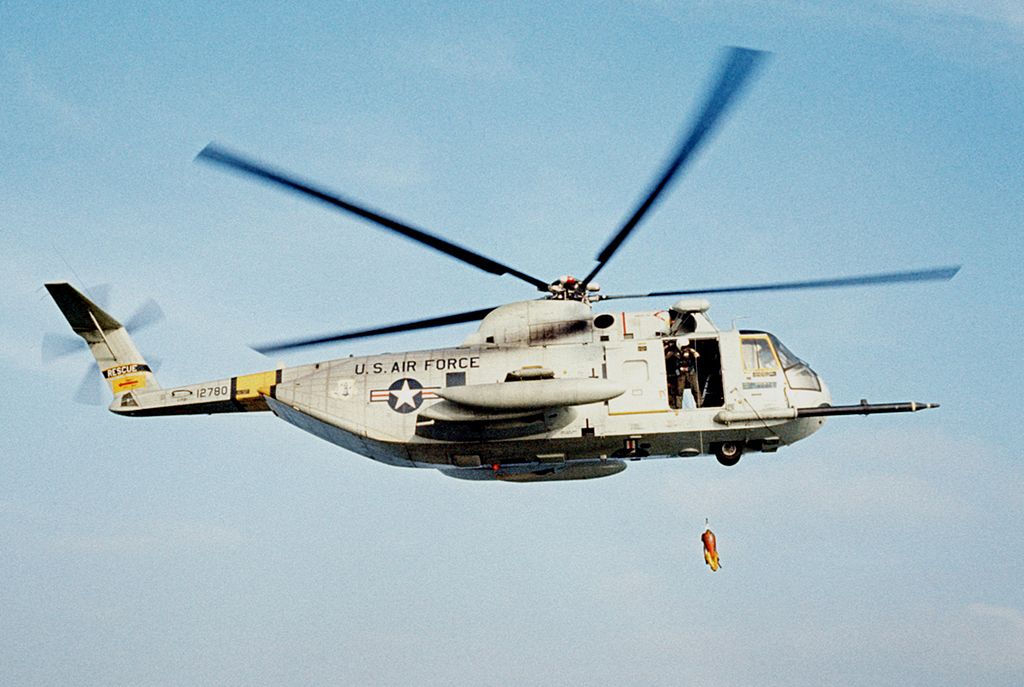
The Sikorsky HH-3E (Sikorsky S-61R) earned the nickname Jolly Green Giant during the Vietnam War. It is a dedicated Combat Search and Rescue (CSAR) helicopter flown by the U.S. Air Force, based on the CH-3C transport helicopter. The aircraft is flown by two pilots and the crew includes a flight mechanic and gunner. It is a large twin-engine helicopter with a single main rotor/tail rotor configuration. It has retractable tricycle landing gear and a rear cargo ramp. The rear landing gear retracts into a stub wing on the aft fuselage. The helicopter has an extendable inflight refueling boom (the HH-3F does not have this capability).
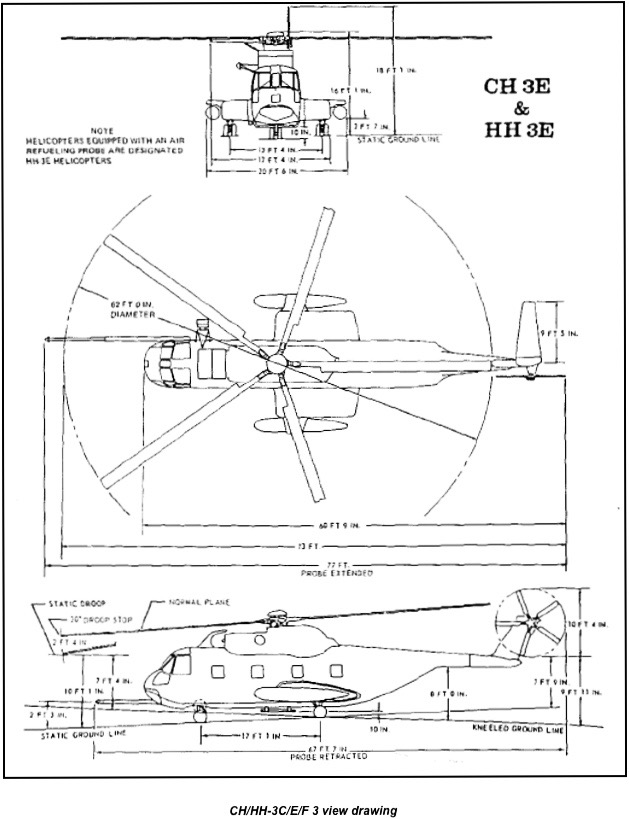
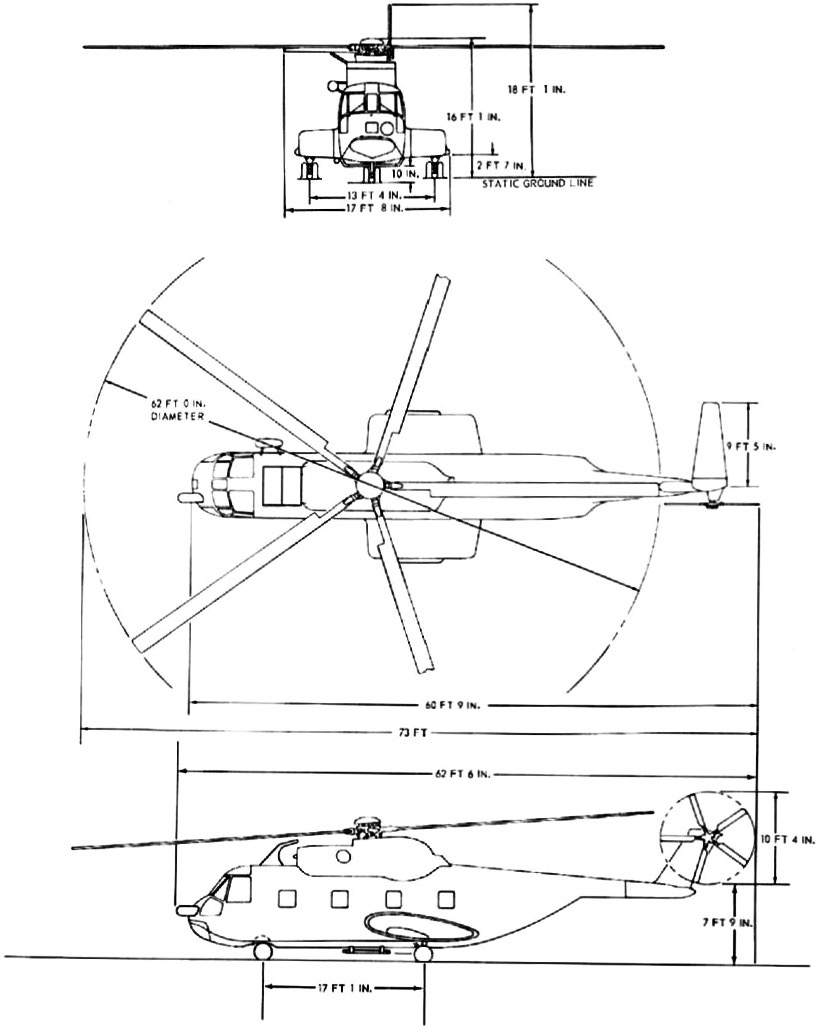
The HH-3E is 72 feet, 7 inches (22.123 meters) long and 18 feet, 10 inches (5.740 meters) high with all rotors turning. The main rotor has five blades and a diameter of 62 feet (18.898 meters). Each blade has a chord of 1 foot, 6.25 inches (0.464 meters). The main rotor turns at 203 r.p.m., counter-clockwise, as seen from above. (The advancing blade is on the right.) The tail rotor also has five blades and has a diameter of 10 feet, 4 inches (3.150 meters). The blades have a chord of 7–11/32 inches (0.187 meters). The tail rotor turns clockwise as seen from the helicopter’s left. (The advancing blade is below the axis of rotation.) The tail rotor turns 1,244 r.p.m.
The HH-3E has an empty weight of 13,341 pounds (6,051 kilograms). The maximum gross weight is 22,050 pounds (10,002 kilograms).
The Jolly Green Giant is powered by two General Electric T58-GE-5 turboshaft engines, which have a Maximum Continuous Power rating of 1,400 shaft horsepower, each, and Military Power rating of 1,500 shaft horsepower. The main transmission is rated for 2,500 horsepower, maximum.
The HH-3E has a cruise speed of 154 miles per hour (248 kilometers per hour) at Sea Level, and a maximum speed of 177 miles per hour (285 kilometers per hour), also at Sea Level. The service ceiling is 14,000 feet (4,267 meters). The HH-3E had a maximum range of 779 miles (1,254 kilometers) with external fuel tanks.
The Jolly Green Giant can be armed with two M60 7.62 mm machine guns.
The very similar HH-3F Pelican is equipped with radar, an Automatic Flight Control System (AFCS) and a navigation computer, which allowed the helicopter to fly coupled search patterns.
The HH-3F served the Coast Guard from 1969 to 1994, when it was replaced by the Sikorsky HH-60J Jayhawk. According to the Sikorsky Historical Archives, during its 25 years of service, the HH-3F saved 23,169 lives, and assisted 65,377 others.
Sikorsky built 14 HH-3Es and 40 HH-3Fs. As many as 50 CH-3Cs and CH-3Es were upgraded to the HH-3E configuration. 5 USAF HH-3Es were converted to HH-3Fs for the Coast Guard. Sikorsky built a total of 173 of the S-61R series.
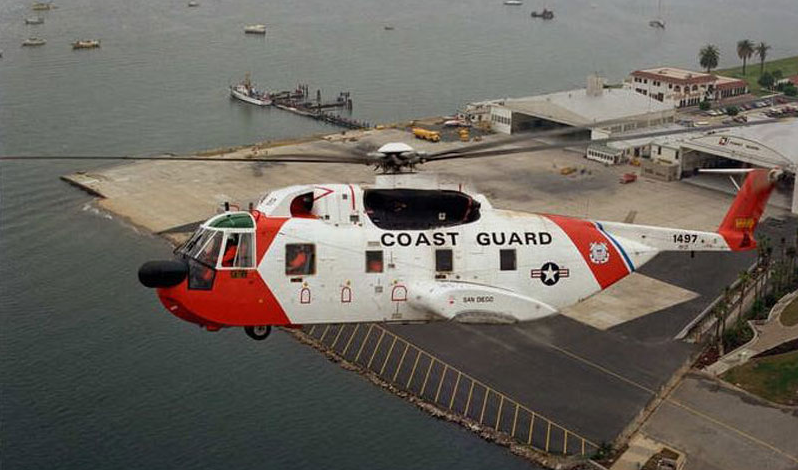
Boeing Vertol CH-113 Labrador
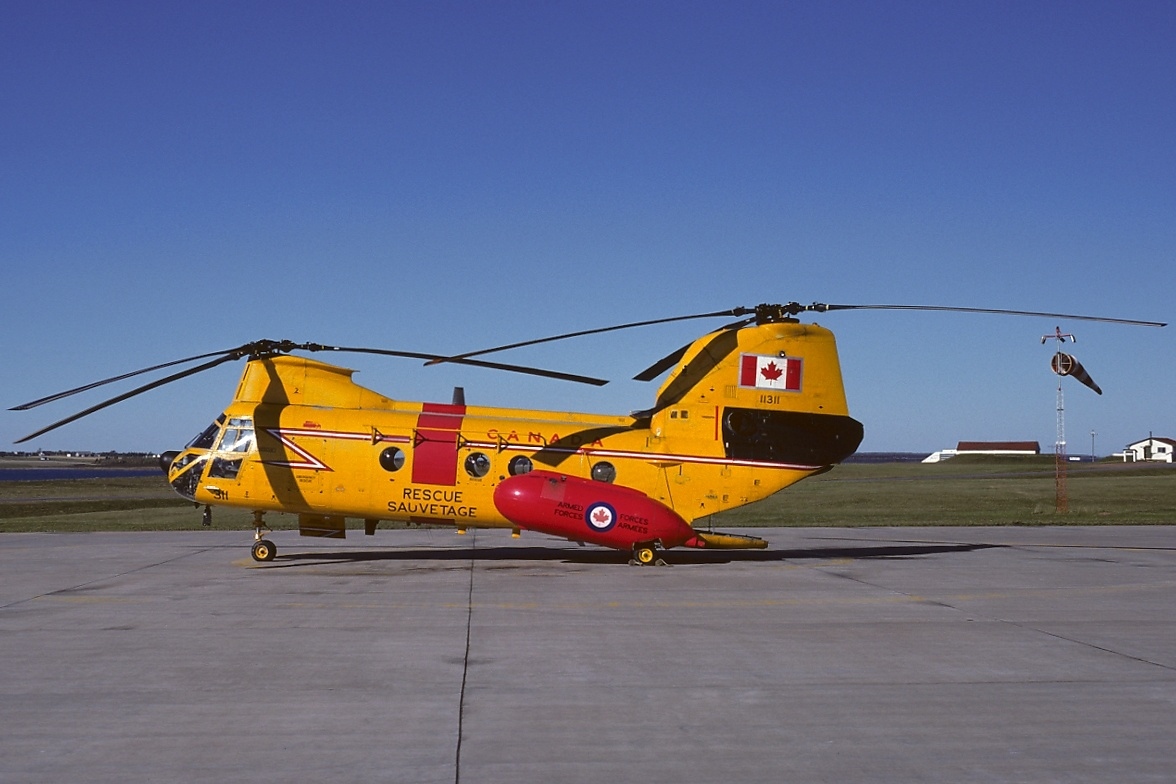
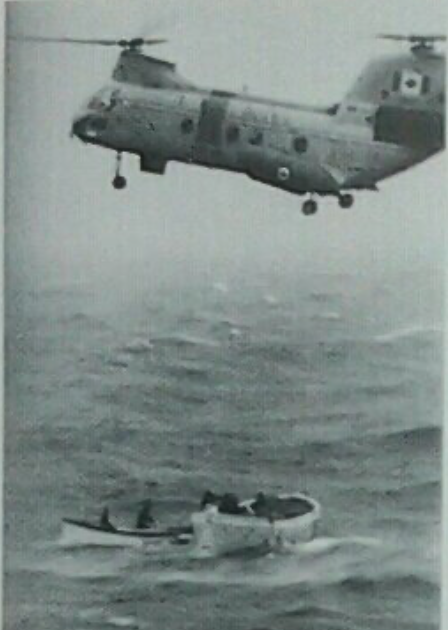
This aircraft is a twin-engine, tandem-rotor search and rescue (SAR) helicopter used by the Canadian Forces from 1963 until 2004. It was a variant of the Boeing Vertol CH-46 Sea Knight designed and built in the United States. A search and rescue version was purchased by the Royal Canadian Air Force in the early 1960s and became known as the Labrador. Soon after, the Canadian Army acquired a troop and cargo version known as the Voyageur. In the mid-1970s, these army machines were replaced by CH-147 Chinook heavy lift and transport helicopters and the Voyageurs were transferred to the air force when Air Command was formed in 1975. They joined the Labradors on search and rescue duties and all were modified to a common search and rescue standard.
Rotor diameter 15.2 m (50 ft)
Length (rotors turning) 25.4 m (83 ft 4 in)
Height 5.1 m (16 ft 8 in)
Weight, Empty 5,104 kg (11,251 lb)
Weight, Gross 9,706 kg (21,400 lb)
Cruising Speed 253 km/h (157 mph)
Max Speed 270 km/h (168 mph)
Rate of Climb 465 m (1,525 ft) /min
Service Ceiling 4,265 m (14,000 ft)
Range 1,100 km (684 mi)
Power Plant Two T-58-GE-8F, 1,500 shaft hp turbines
De Havilland Canada CC-115 Buffalo
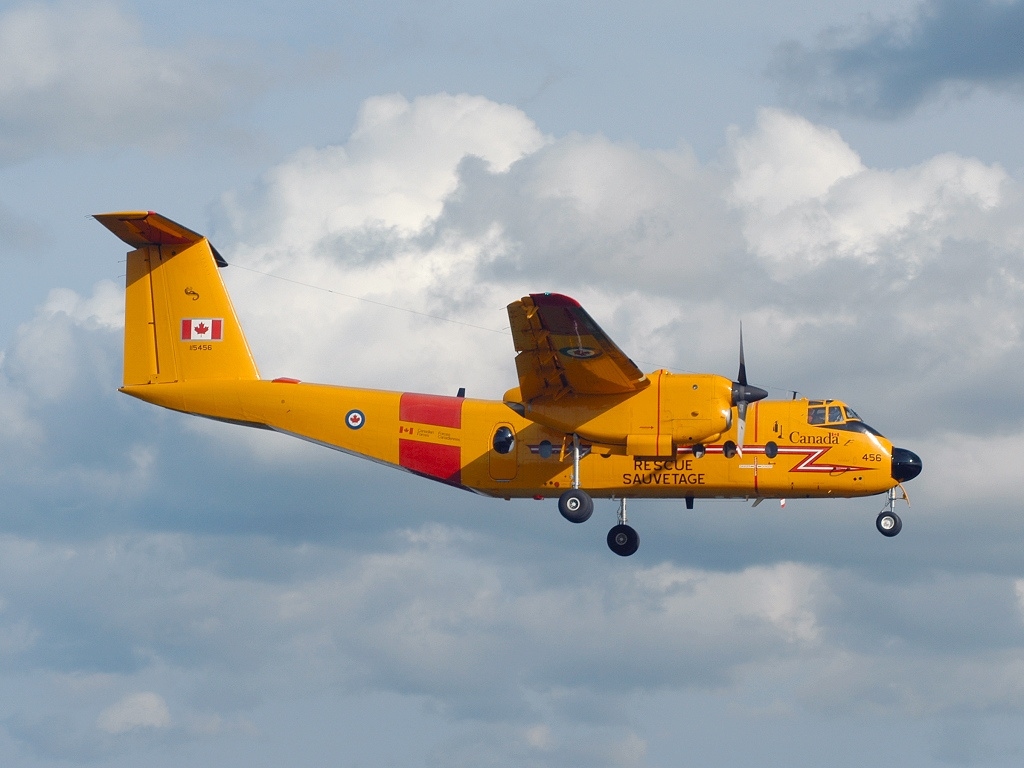
The CC-115 Buffalo plays a critical role in supporting life-saving search and rescue missions. Its agility and all-weather capabilities are well suited for the rough and mountainous terrain on Canada’s West Coast and in northern operations.
The Buffalo is a utility transport aircraft that can take off and land on the most rugged strips as short as a soccer field. It serves a vast territory from the British Columbia / Washington border to the Arctic and from the Rocky Mountains to 1,200 kilometers out over the Pacific Ocean.
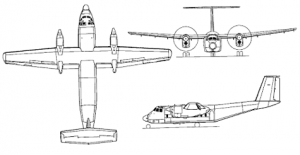 Length 24 m
Length 24 m
Wingspan 29.25 m
Height 8.53 m
Empty weight 12,474 kg
Maximum gross weight 19,560 kg
Maximum speed 420 km/h
Range 2,240 km
Locations Comox, B.C.
This aircraft is used for Search and rescue
Canadair CP-107 Argus
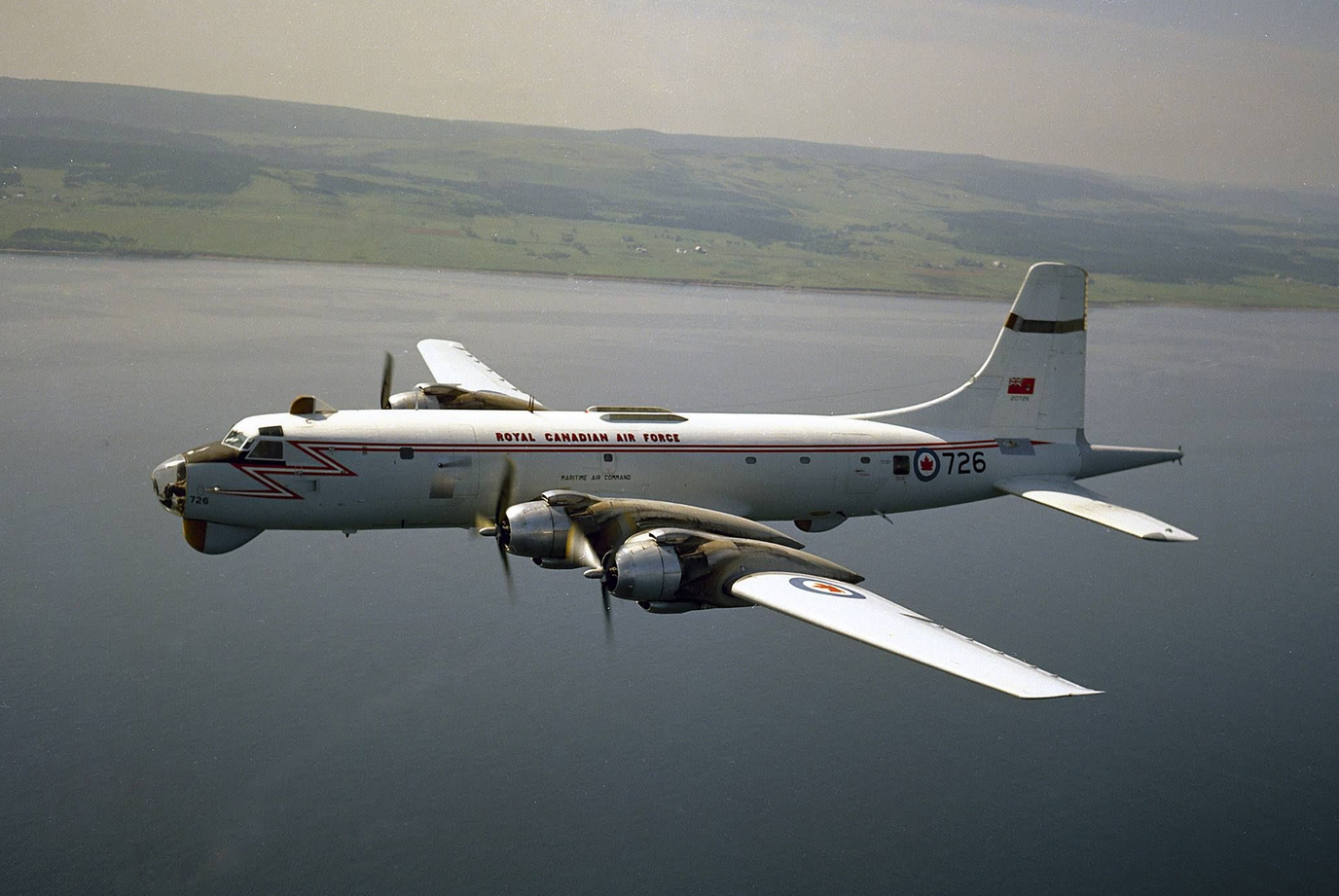
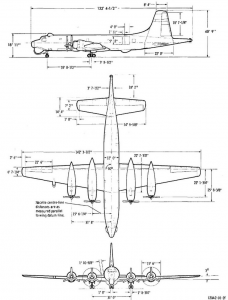 The Canadian-built Canadair Argus was a unique hybrid that married the wings, tail surfaces and undercarriage of the British-designed Britannia transport to a completely new Canadian-designed, non-pressurized fuselage that was equipped with different American-designed engines. One of the most effective anti-submarine warfare aircraft of its day, the Argus was a mainstay for the RCAF in the maritime role. The principal difference between the Mark I and Mark II was in the different internal navigation, communication and tactical electronic equipment. Externally, the Mk II exhibited a redesigned smaller nose radome and additional ECM (electronic counter measures) antennae above the fuselage. The Argus replaced the Lancaster and Neptune aircraft types previously flown in the maritime roles and, eventually, the Argus was itself replaced by the current CP-140 Aurora aircraft.
The Canadian-built Canadair Argus was a unique hybrid that married the wings, tail surfaces and undercarriage of the British-designed Britannia transport to a completely new Canadian-designed, non-pressurized fuselage that was equipped with different American-designed engines. One of the most effective anti-submarine warfare aircraft of its day, the Argus was a mainstay for the RCAF in the maritime role. The principal difference between the Mark I and Mark II was in the different internal navigation, communication and tactical electronic equipment. Externally, the Mk II exhibited a redesigned smaller nose radome and additional ECM (electronic counter measures) antennae above the fuselage. The Argus replaced the Lancaster and Neptune aircraft types previously flown in the maritime roles and, eventually, the Argus was itself replaced by the current CP-140 Aurora aircraft.
Designation CP-107
Model number CL-20
Marks Mk I, II
Role Anti-submarine warfare (ASW)
Taken on strength 1957
Struck off strength 1982
Number 33
Service RCAF and Canadian Armed Forces
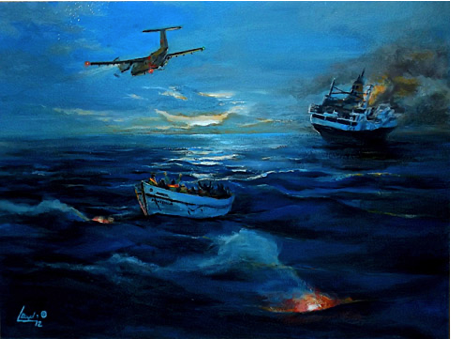
¹ “night sun” refers to the Spectrolab Inc. Nightsun® high-intensity searchlight for aircraft.
© 2020, Sean M. Cross
Medal of Honor, Second Lieutenant John Cary Morgan, United States Army Air Corps
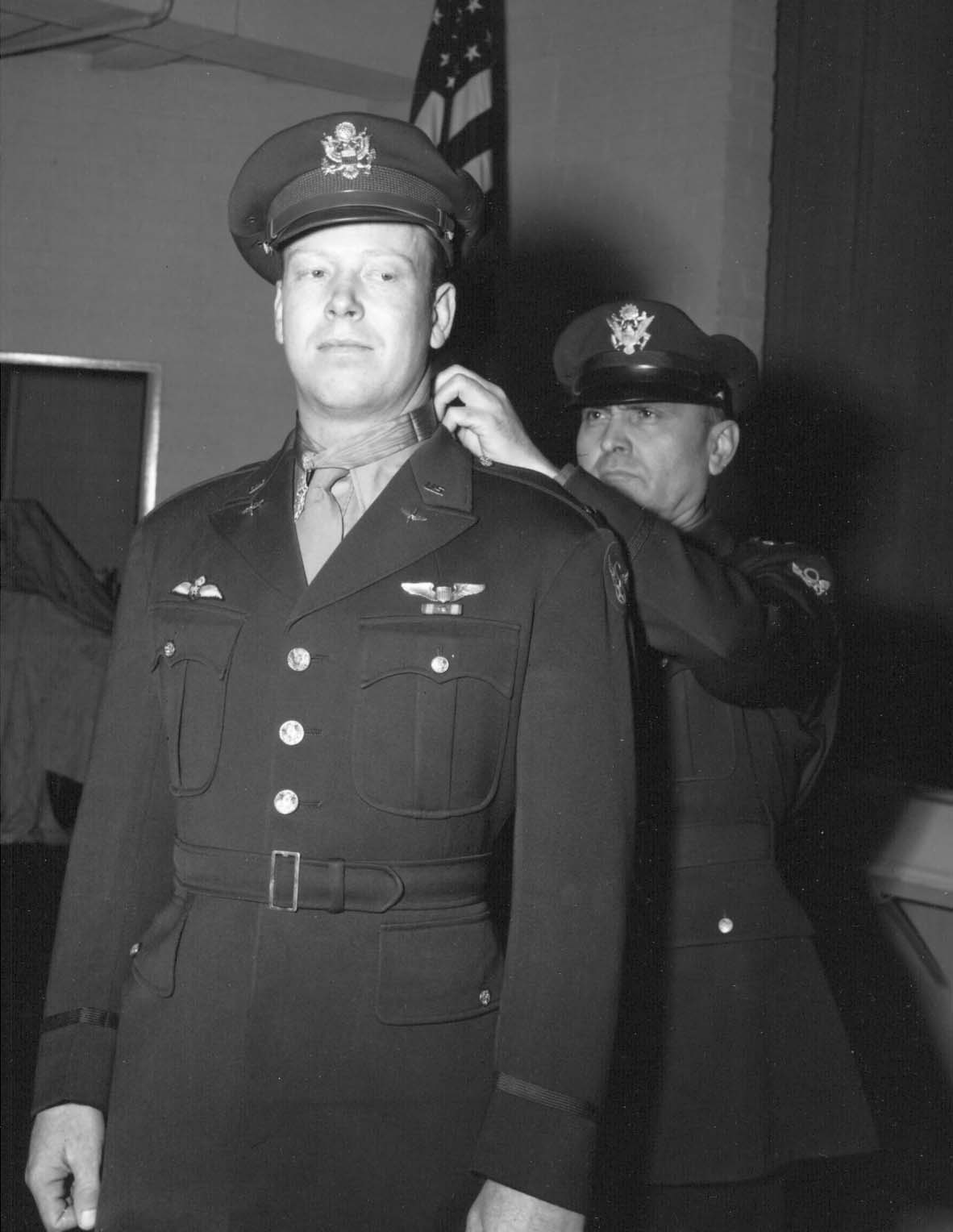
MEDAL OF HONOR
MORGAN, JOHN C. (Air Mission)
Rank and organization: Second Lieutenant, U.S. Army Air Corps, 326th Bomber Squadron, 92d Bomber Group.
Place and date: Over Europe, 28 July 1943.¹
Entered service at: London, England. Born: 24 August 1914, Vernon, Texas.
G.O. No.: 85, 17 December 1943.
Citation:
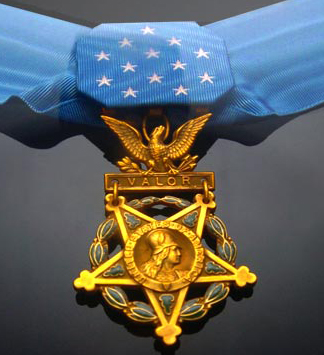
“For conspicuous gallantry and intrepidity above and beyond the call of duty, while participating on a bombing mission over enemy-occupied continental Europe, 28 July 1943.¹ Prior to reaching the German coast on the way to the target, the B17 airplane in which 2d Lt. Morgan was serving as copilot was attacked by a large force of enemy fighters, during which the oxygen system to the tail, waist, and radio gun positions was knocked out. A frontal attack placed a cannon shell through the windshield, totally shattering it, and the pilot’s skull was split open by a .303 caliber shell, leaving him in a crazed condition. The pilot fell over the steering wheel, tightly clamping his arms around it. 2d Lt. Morgan at once grasped the controls from his side and, by sheer strength, pulled the airplane back into formation despite the frantic struggles of the semiconscious pilot. The interphone had been destroyed, rendering it impossible to call for help. At this time the top turret gunner fell to the floor and down through the hatch with his arm shot off at the shoulder and a gaping wound in his side. The waist, tail, and radio gunners had lost consciousness from lack of oxygen and, hearing no fire from their guns, the copilot believed they had bailed out. The wounded pilot still offered desperate resistance in his crazed attempts to fly the airplane. There remained the prospect of flying to and over the target and back to a friendly base wholly unassisted. In the face of this desperate situation, 2d Lt. Officer Morgan made his decision to continue the flight and protect any members of the crew who might still be in the ship and for 2 hours he flew in formation with one hand at the controls and the other holding off the struggling pilot before the navigator entered the steering compartment and relieved the situation. The miraculous and heroic performance of 2d Lt. Morgan on this occasion resulted in the successful completion of a vital bombing mission and the safe return of his airplane and crew.”
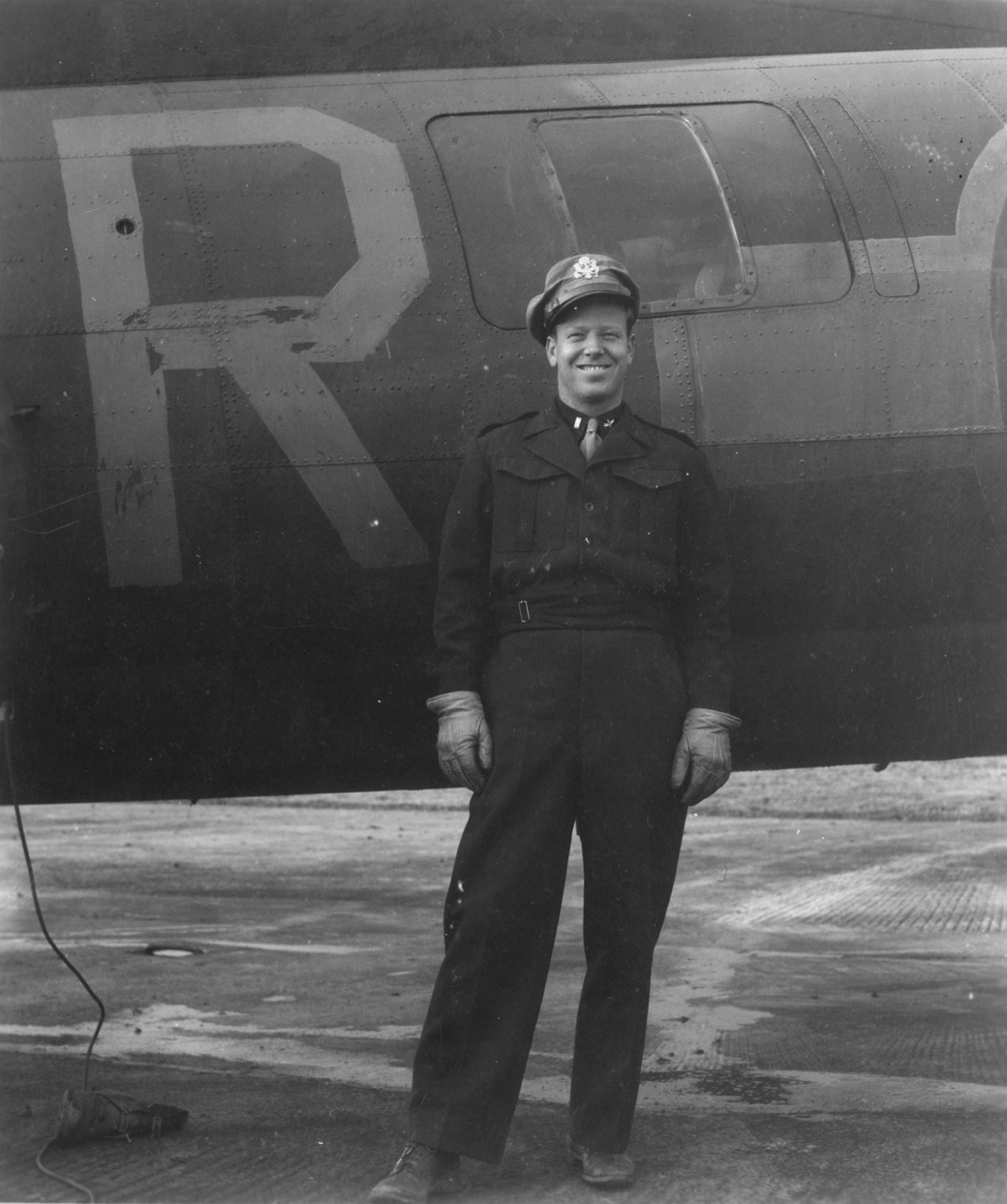
John Cary Morgan was born 24 August 1914 at Vernon, Texas, the first of four children of Samuel Asa Leland Morgan, an attorney, and Verna Johnson Morgan. He was educated at the New Mexico Military Institute, and also attended Amarillo College, West Texas Teacher’s College and the University of Texas at Austin.
“Red” Morgan traveled to the South Pacific in 1934, working on a pineapple plantation in the Fiji Islands. He returned to the United States in 1937, arriving at the Port of Los Angeles from Suva, Fiji, aboard the Matson passenger liner S.S. Monterey, on 6 September, after a 12-day voyage.
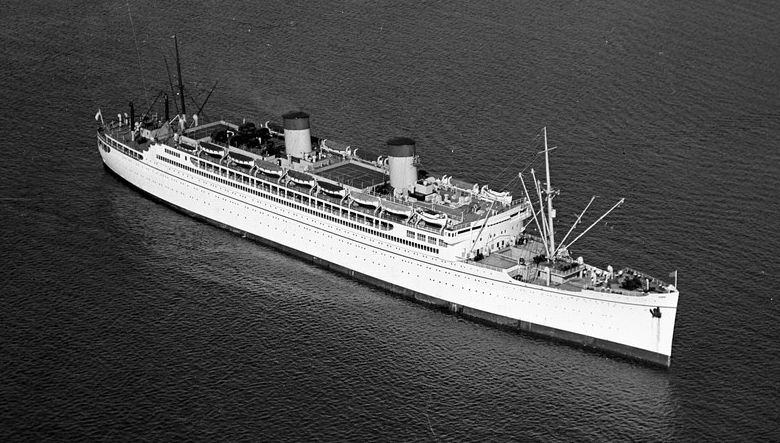
Morgan married 20-year-old Miss Margaret Wilma Maples at the First Methodist Church, Oklahoma City, Oklahoma, 3 December 1939. The ceremony was performed by Rev. Lewis N. Stuckey. They were divorced, 1 May 1941.
Morgan registered for Selective Service at Oklahoma City, 16 October 1940. He was described as being 6 feet, 2 inches (1.88 meters) tall, weighing 180 pounds (81.7 kilograms), with red hair and blue eyes. Morgan had broken his neck in an oil field accident before the United States entered World War II, and had been classified 4-F by the draft board: “not qualified for military service.”
Morgan went to Canada and on 4 August 1941, enlisted in the Royal Canadian Air Force. After flight training, he was sent to England and assigned to RAF Bomber Command. Flight Sergeant Morgan flew twelve combat missions with the RAF. He was then transferred to the U.S. Army Air Corps with the warrant rank of Flight Officer. On 23 March 1943, Red Morgan was assigned to the 326th Bombardment Squadron (Heavy), 92nd Bombardment Group (Heavy), at RAF Alconbury (Army Air Force Station 102), at Huntingdon, Cambridgeshire, England.
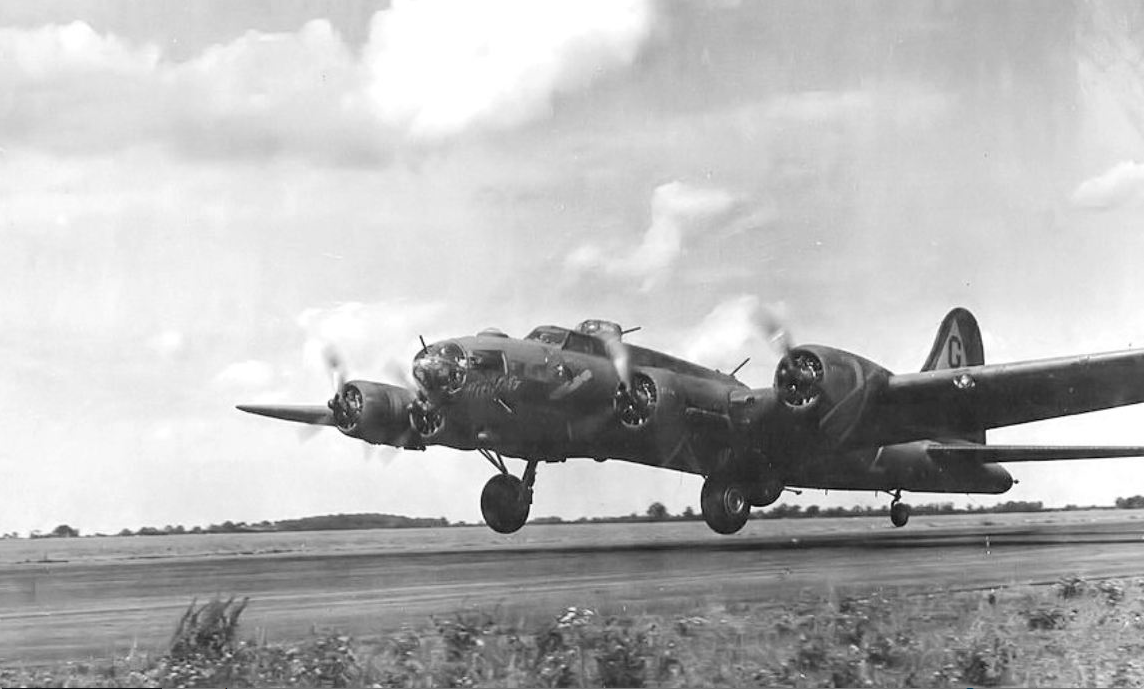
The incident for which Morgan was awarded the Medal of Honor occurred during his fifth combat mission with the 326th Bombardment Squadron. He was the co-pilot of a Boeing B-17F-70-BO Flying Fortress, serial number 42-29802, named Ruthie II.
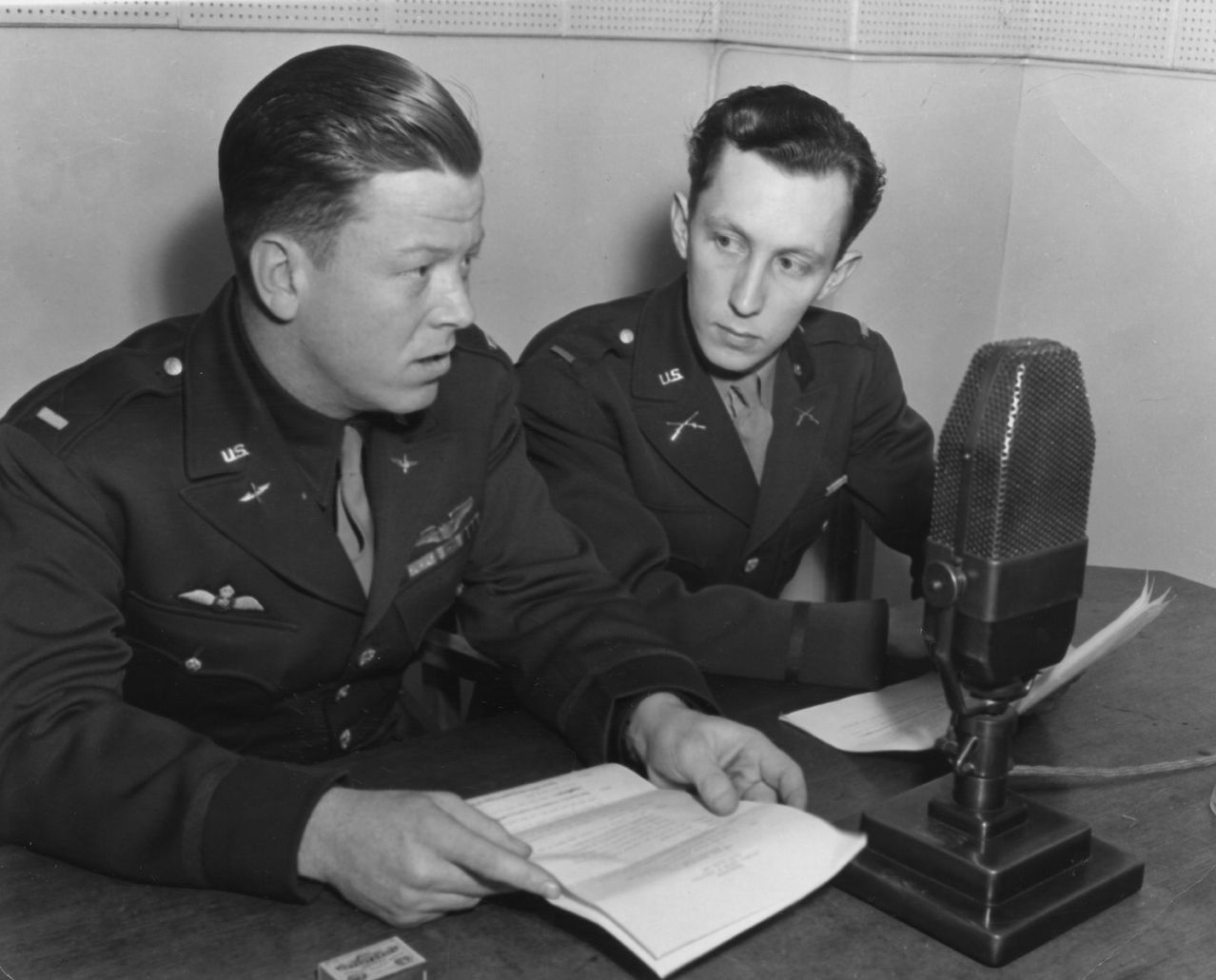
Promoted from flight officer to 2nd lieutenant, John C. Morgan continued to fly combat missions, now with the 482nd Bombardment Group (Pathfinder). On 6 March 1944, the H2X radar-equipped B-17 on which he was co-pilot, Douglas-Long Beach-built B-17F-70-DL 42-3491, was hit by an 88-millimeter anti-aircraft artillery shell and shot down. The aircraft commander, Major Fred A. Rabo, Lieutenant Morgan, and two others escaped as the airplane exploded. Six airmen were killed, including Brigadier General Russell A. Wilson.
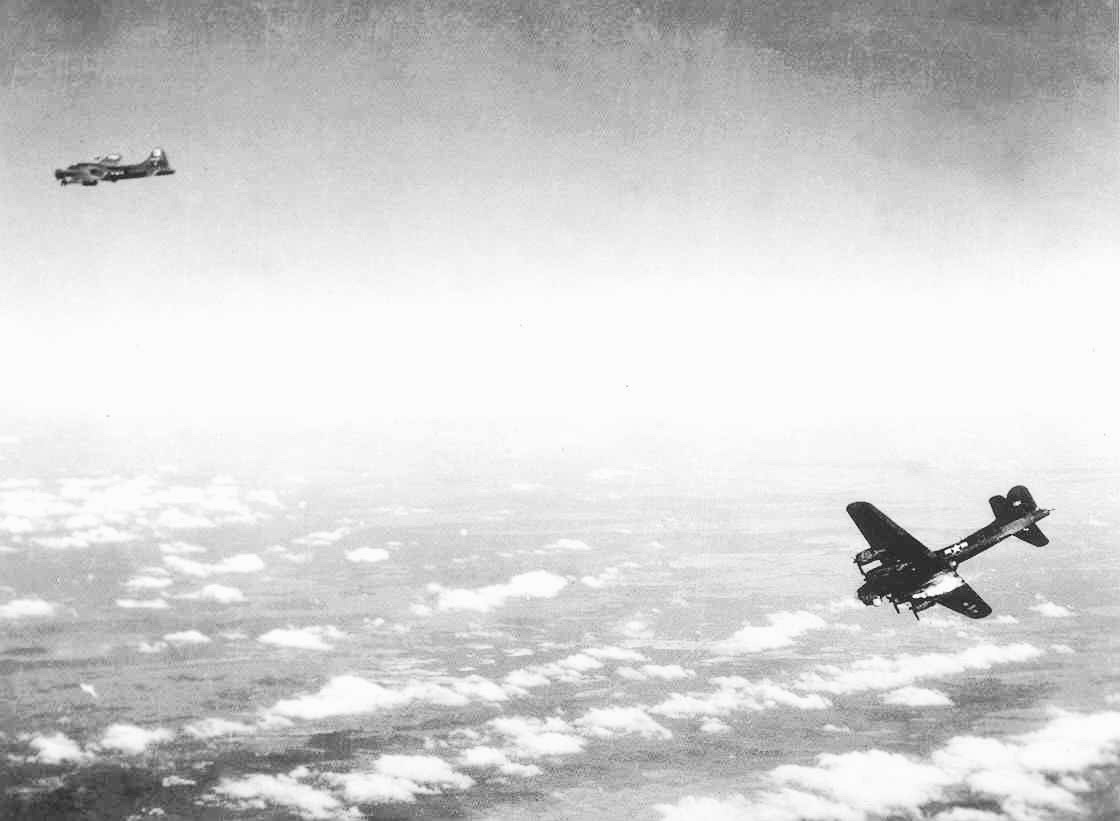
The survivors were captured. Lieutenant Morgan spent the rest of the war as a prisoner at Stalag Luft I. He is the only Medal of Honor recipient to have been held as a Prisoner of War after being awarded the Medal.
Lieutenant Morgan was separated from active duty 29 January 1946, but remained in the Air Force Reserve. In the civilian sector, Morgan worked for the Texaco oil company.
Red Morgan married Chris Ziegler of Chicago, Illinois, who was a secretary for Texaco, in 1947. They had one son. According to an obituary in the New York Times, Morgan had a third wife, Gladys, at the time of his death.
Morgan was promoted to the rank of major in July 1950. Recalled to active duty during the Korean War (from June 1951 to August 1953), he was assigned to the Technical Training Command. Morgan was promoted to lieutenant colonel in August 1957.
Lieutenant Colonel John Cary Morgan, United States Air Force, died at Midlands Hospital, Papillon, Nebraska, 17 January 1991, at the age of 76 years. He was buried at Arlington National Cemetery.
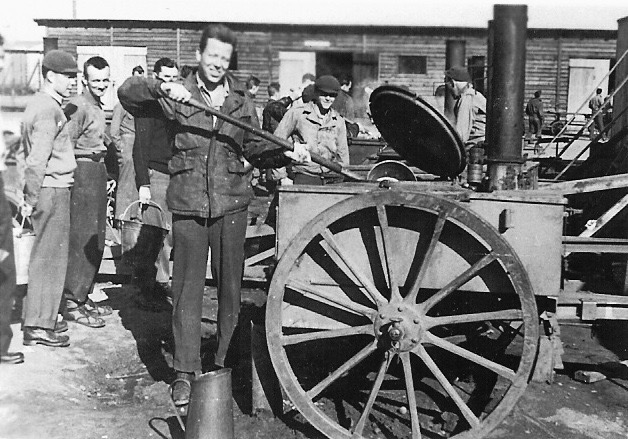
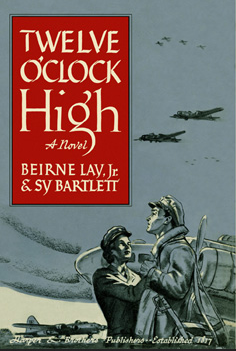
Authors Beirne Lay, Jr., and Sy Bartlett used Morgan as the model for the character of “Lieutenant Jesse Bishop” in their novel, Twelve O’Clock High, and the Academy Award-winning 1949 motion picture adaptation that followed. The Jesse Bishop character was played by actor Robert Patten, a USAAF navigator during World War II.
¹ “Although both the original fact sheet and the official Medal of Honor citation give the date as 28 July 1943, official records of the 92d Bombardment Group pinpoint it as 26 July. See Memo, Lt. Col. Andre R. Brosseau, Operations Officer, Headquarters, 92d Bombardment Group to Commanding Officer, 92d Bombardment Group, subj: Report on Planning and Execution of Operations for Mission 26 July 1943, Hannover, Germany, 27 July 1943, Air Force Historical Support Division, Reference Branch documents. The memo does not detail Flight Officer Morgan’s actions but does pinpoint the mission to Hannover on 26 July 1943.” —Air Force Historical Support Division
© 2017, Bryan R. Swopes

